If I ask you to think of wasps, the first thoughts that come to mind likely aren’t positive ones.
Striped summer picnic ruiners? Overly aggressive lemonade addicts? Having been stung a few times both as a kid and an adult, I understand the sentiment.
But did you know not all wasps are yellow and black menaces?
There are tens of thousands of wasp species, of which around 4,000 can be found in the United States. This group of insects is found worldwide, and has been around since the Jurassic period. That’s roughly two hundred million years!
Nowadays, the “wasp” definition includes various different scientific families. It’s not surprising, then, that not all of them are evil. Remember: Many wasps eat insects, meaning they can actually help protect your crops and decorative plants from pests.
Do you know the difference between a bee and a wasp when you find them in your garden? Can you tell an innocent solitary burrowing wasp from a yellowjacket? Do you know which species of hornet are dangerous, and which you should welcome near your home?
Let’s have a look at everything wasp that you may encounter in your backyard! Don’t forget to bookmark this guide for the next time you come across a striped flying insect and want to know whether to panic or not.

How to tell the difference between bees and wasps
As discussed in the full guide to easy bee identification, both bees and wasps are common garden visitors. While wasps can be quite useful, their reputation is ruined by a few “bad apples” among the thousands of different species you may come across.
Bees, on the other hand, are almost always inoffensive unless you accidentally smush or threaten them. If they sting, they often die, so many reserve this ability only for situations they consider a severe threat to their hive.
It’s generally not too difficult to tell the difference between bees and wasps. Although both belong to the same scientific suborder, Apocrita (which also contains ants), they’re quite different if you take a minute to look at them a little more closely.
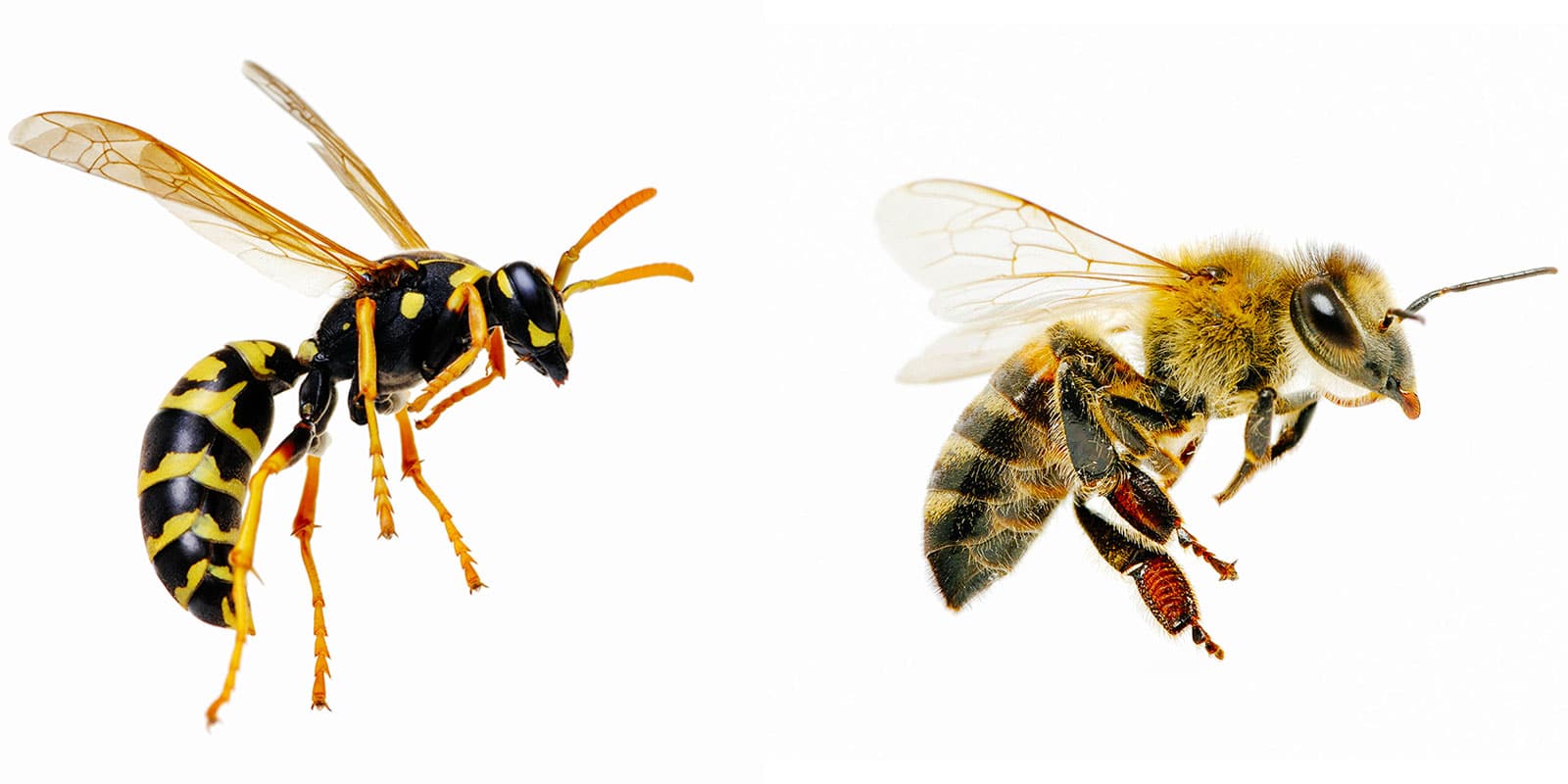
The first thing you should ask yourself is: Is it furry? If the answer is yes, you’re most likely dealing with a bee, not a wasp. The rotund bumblebee is the hairiest among them, and also one of the least offensive.
Wasps are mostly free of fuzz. They’re also more brightly colored, with well-defined yellow and black stripes on most of the species that can cause trouble. They have cinched waists and will be much more interested in your picnic than a bee.
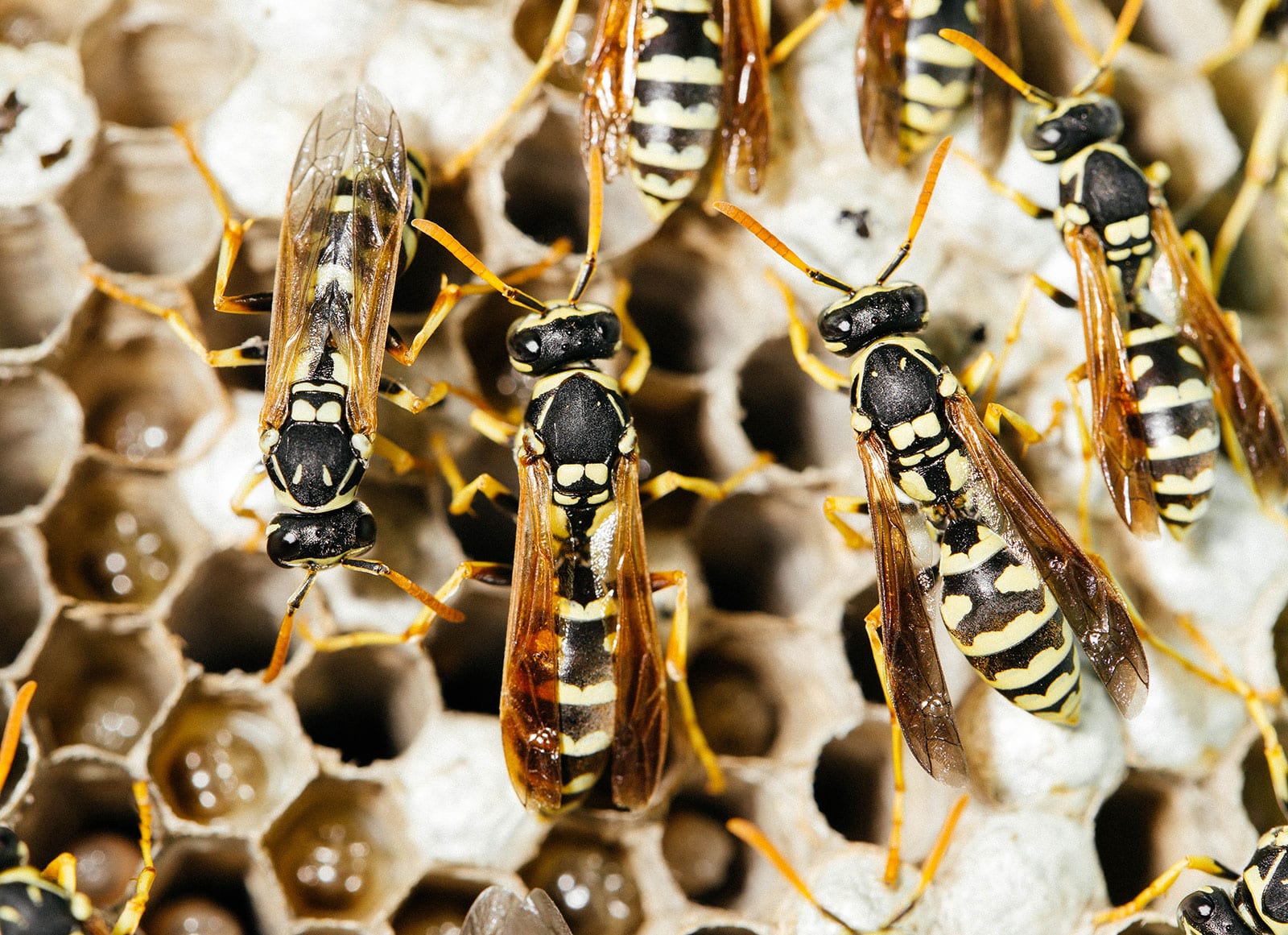
Common misconceptions about wasps
As with many garden bugs, there are quite a few myths out there about wasps. Some of these may cause you to go after wasps that don’t deserve it. Others can lead to dangerous situation, like the belief that it’s safe to remove a wasp nest at night because you “won’t be stung.”
Let’s quash a few of those harmful wasp myths!
Myth #1: Wasps serve no function.
Wrong! If your garden contained no wasps or hornets, there’s a good chance it’d be full of annoying pests like caterpillars (including hornworms that can decimate your tomato plants) and aphids. This is because many species of wasps are actually not just lemonade lovers, but also big bug hunters. Spiders alone wouldn’t be able to keep up!
Related: Learn how to identify the striped caterpillars in your garden
To add to this, there are also parasitoid wasps that lay their eggs in other wasp nests. Their larvae eat the existing larvae, thereby helping to actually reduce annoying species while being pretty inoffensive themselves.
Myth #2: Wasps don’t pollinate plants.
Actually, many do, as the adults of a good few species love snacking on nectar. As they feed, they spread pollen between flowers, helping native plant species thrive.
Bees get all the glory when it comes to pollination, but wasps (and other pollinators like lacewings and hummingbirds) do some of the work, too!
Read more: Want to attract more pollinators? Here’s how to make bug food for ladybugs and lacewings, grow bee-friendly flowers, plant flowers that hummingbirds love, and make hummingbird food when no flowers are in bloom
Myth #3: All wasps are aggressive.
A big percentage of the wasp species that inhabit your garden are actually mostly inoffensive. Unless you disturb their nest, which isn’t very common, they’re perfectly content to just go about their business.
This even applies to the “picnic ruiners” (aka yellowjackets), which usually just want their hot dog or soda and don’t attack unless you swat at them (and why they get such a bad rap—it’s hard to just sit there and let them land on your food!).
As a gardener, I’ve had many days of working alongside paper wasps in my raised beds and been amazed at how docile they were—they were just doing their own thing, flying around looking for nectar.
Myth #4: Baking soda brings wasp sting relief.
Apparently, this one came about due to the fact that it was believed the venom that wasps inject is acidic. Alkaline baking soda would supposedly neutralize it.
On the contrary, wasp venom actually consists of a mix of components, and the efficacy of baking soda has never been proven.
Myth #5: All wasps sting.
Nope! Since a stinger is a modified ovipositor (an anatomical feature that allows females to lay eggs), most male wasps can’t sting at all. And female wasps usually don’t sting unless they’re defending themselves or capturing prey.
Some have a modified ovipositor that allows them to lay eggs in other wasps’ nests but makes them unable to attack. Others just evolved to lose their stinger altogether.
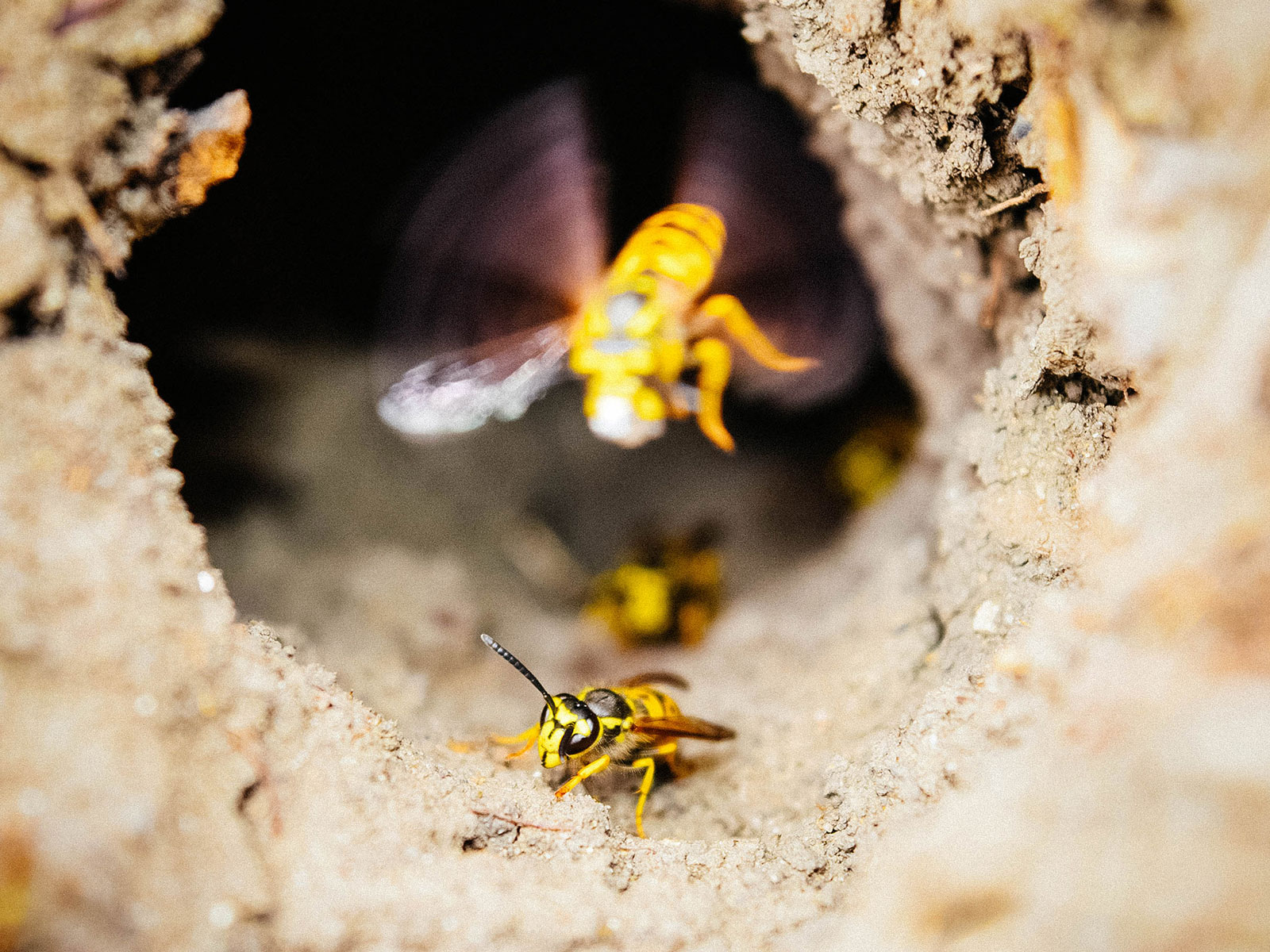
Wasp identification for dummies
Okay, so there’s more to wasps than just annoying yellowjackets and scary hornets. But how in the world are you supposed to know whether to call an exterminator, or enjoy the presence of a fascinating insect in your garden?
Luckily, the “basic” wasp species aren’t too challenging to identify. Let’s have a look at the most common backyard wasps here in the US and whether they should be avoided or not.
Solitary vs. social wasps: What’s the difference?
In order to understand wasps, it’s helpful to know that they can generally be divided into two different groups. The solitary wasps are the most common, but less well-known.
Solitary wasps
There are loads of different species of solitary wasps out there. Most are predatory, but they can have completely different specialties. Many don’t look at all like what you’d expect of a wasp and will generally leave you alone.
The largest groups of solitary wasps in the US include:
- Family Sphecidae, the thread-waisted wasps. These include the mud dauber and sand wasps.
- Subfamily Chrysidinae, the cuckoo wasps. These are often a shiny blackish-green in color and derive their name from the fact that they lay eggs in other wasps’ nests (the same behavior as the cuckoo bird, which lays in eggs in other birds’ nests).
- Subfamily Eumeninae, the potter wasps. These build small nests made of mud.
- Family Tiphiidae and Scoliidae, the tiphiid and scoliid wasps. These wasps are parasitic, laying their eggs in insect larvae.
- Family Mutillidae, the velvet ant. Despite their name, these hairy insects are wasps. They’re not aggressive but do have a very painful sting.
Social wasps
Social wasps, as their name suggests, are not solitary. Rather, they inhabit shared nests, which they build and maintain together. Nests usually only contain a few dozen wasps, but in some cases can be inhabited by thousands.
Members of the family Vespidae, the 20 or so social wasps that inhabit North America, are probably what you imagine when you think of a wasp. They’re usually bright yellow and black in color, and can cause trouble when not managed properly.
Pretty much all social wasps are members of the scientific family Vespidae. Subfamilies in the US include:
- Vespinae, the main offenders when it comes to ruined picnics and dangerous situations. They include the true hornets and yellowjackets.
- Polistinae, which are often known as paper wasps, despite not being the only wasps that use wood pulp to build their nest.
Did you know?
The prize for smallest flying insect goes to a wasp. Members of the genus Mymaridae, the fairyflies, can be as small as 0.13mm! Since they’re often egg parasites, these micro wasps have actually been used as biological pest control.
19 common types of backyard wasps
Yellowjacket (Vespula, Dolichovespula)
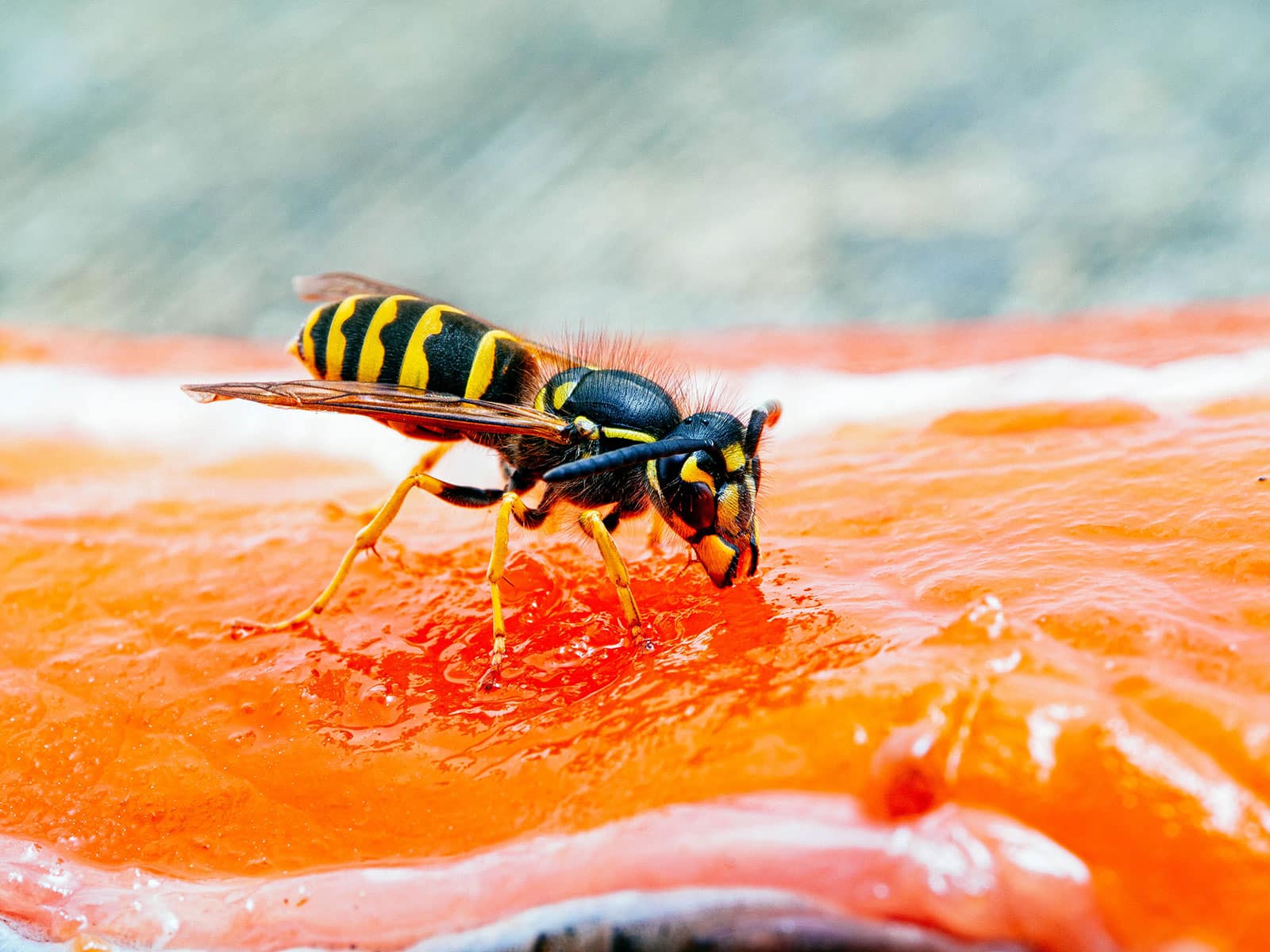
Probably the exact insect you imagine when you think of a wasp, the yellowjacket is ubiquitous and can be pretty darn annoying. Made up of the genera Vespula and Dolichovespula, there are a good few different species present in North America.
They grow to a maximum size of around 0.5 inch and sport yellow and black or white and black patterns.
Yellowjacket larvae feed on insects, which are caught for them by the adults. Unfortunately, their tastes change when they metamorphose into adults.
At this point, they develop a love for carbs like nectar, fruit, and, unfortunately, the sweet foods and drinks us humans also enjoy. As any tailgater or BBQer knows, yellowjackets also have a thing for protein, going after deli meats and grilled meats when nothing else is available.
A yellowjacket will usually leave you alone unless you swat at it or get too close to its nest. Still, stings do occur unprovoked, and they can be painful. If a person is allergic, an encounter with these wasps can be dangerous.
The most common yellowjackets include:
- German yellowjacket (Vespula germanica): Non-native candy addicts with thick bodies.
- Western yellowjacket (Vespula pensylvanica): The most common in the US.
- Eastern yellowjacket (Vespula maculifrons): Pensylvanica’s close cousin. Generally more black coloration on the body.
- Southern yellowjacket (Vespula squamosa): Common in the southeast. Can build gigantic nests, since colonies are often perennial.
- Common aerial yellowjacket (Dolichovespula arenaria): Though this one’s widely spread in North America, it’s not one of the big troublemakers.
European hornet (Vespa crabro)
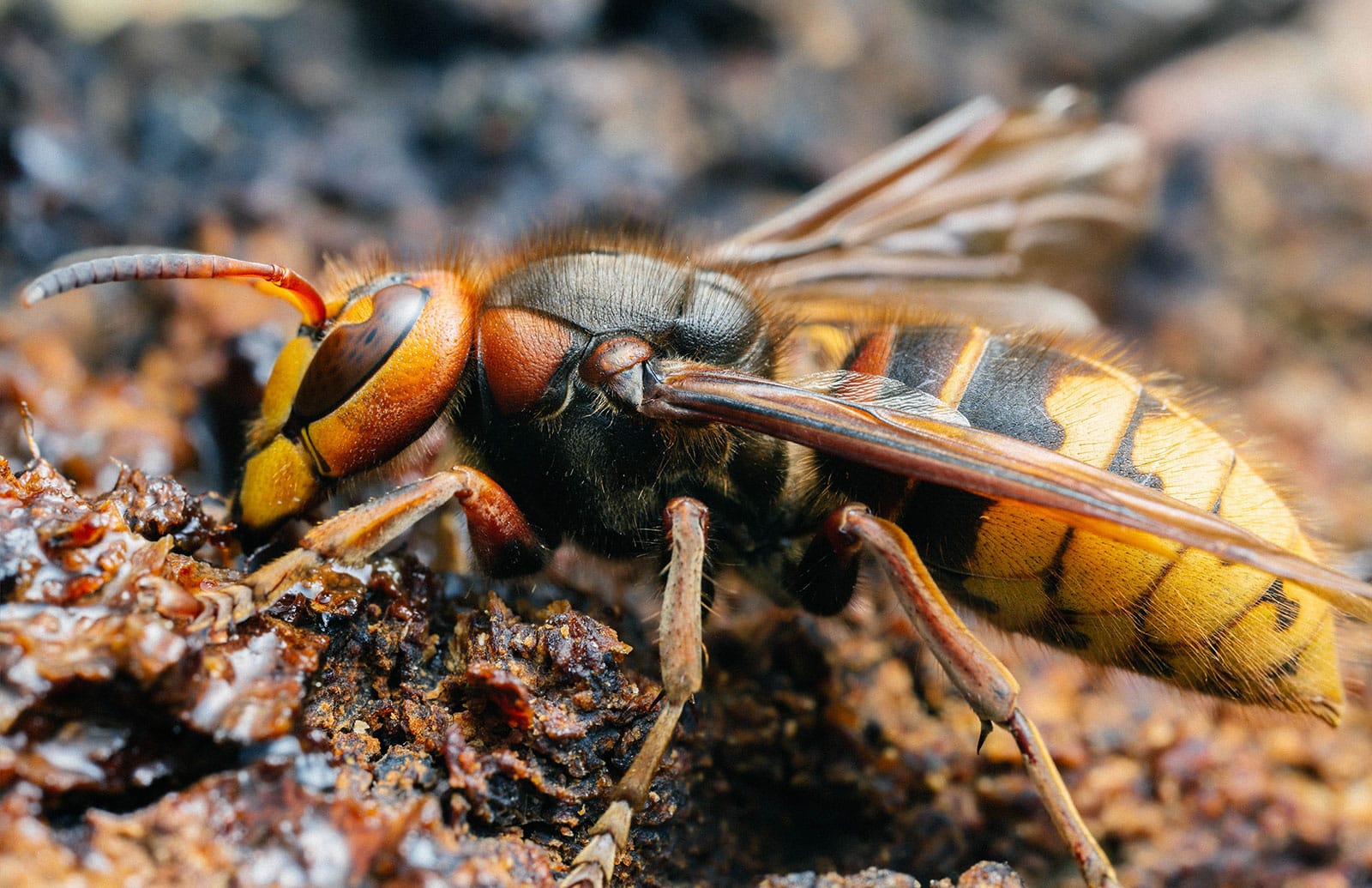
As their name suggests, European hornets are an introduced species in the US. Of the wasps you may find in your garden, they are probably one of the scariest in terms of looks!
These guys are bigger than most other wasp species in the US, with a maximum size of around an inch.
Despite their size, European hornets are not as worrisome as you may think. Unlike yellowjackets, they’re not big fans of sugary drinks and foods, preferring meaty meals. This means they usually go about their business without bothering you.
They can sting, and it’s painful, but their venom is not strong and they will leave you alone unless you disturb their nest.
Northern paper wasp (Polistes fuscatus)
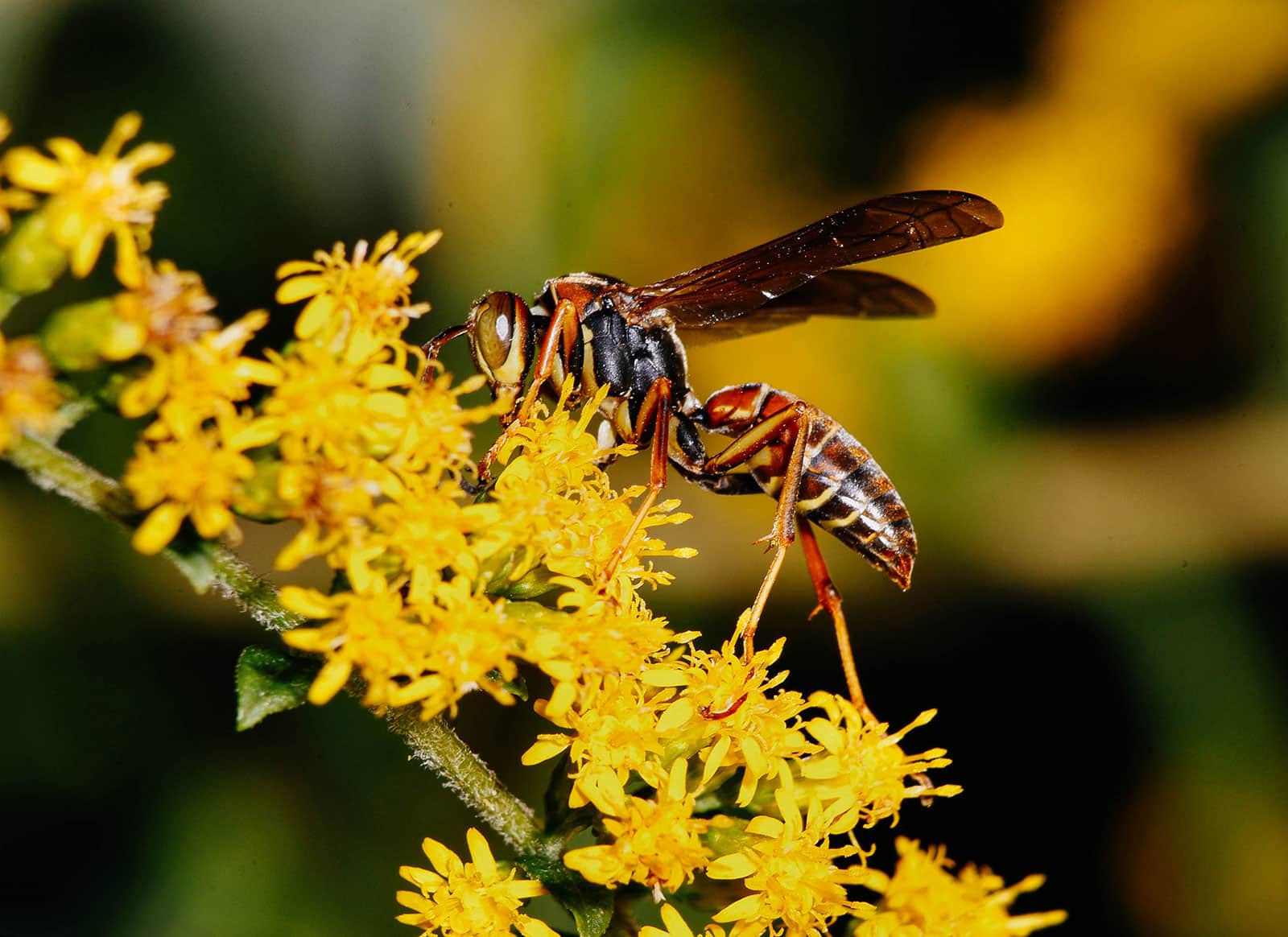
Of the paper wasps, the species you’ll most commonly encounter is Polistes fuscatus, the northern paper wasp. This skinny red, black, and yellow species sports dark wings and can reach a size of just under an inch. Like other paper wasps, it has long legs.
Although the northern paper wasp does make nests in our gardens, using regurgitated pulp scraped off wood frames, garden furniture, and more, it’s not a big source of problems.
Colonies are usually small. Aside from perusing our wooden items, they leave us alone and will not attack unless their nest is disturbed.
European paper wasp (Polistes dominula)

One invasive paper wasp species in the US is the European paper wasp. This one looks a lot like a yellowjacket, but although it can occasionally be cranky, it will usually not seek out humans.
If you do see one, it’s generally not after your soda. European paper wasps are more focused on chewing up your garden furniture and other wooden objects.
Learn more: How to get rid of carpenter bees without poison
The best way to tell a European paper wasp apart from a yellowjacket is by looking at it in-flight. They’ll trail their back legs loosely behind them, whereas yellowjackets tuck them in.
Red paper wasp (Polistes carolina, rubiginosus, canadensis, etc.)
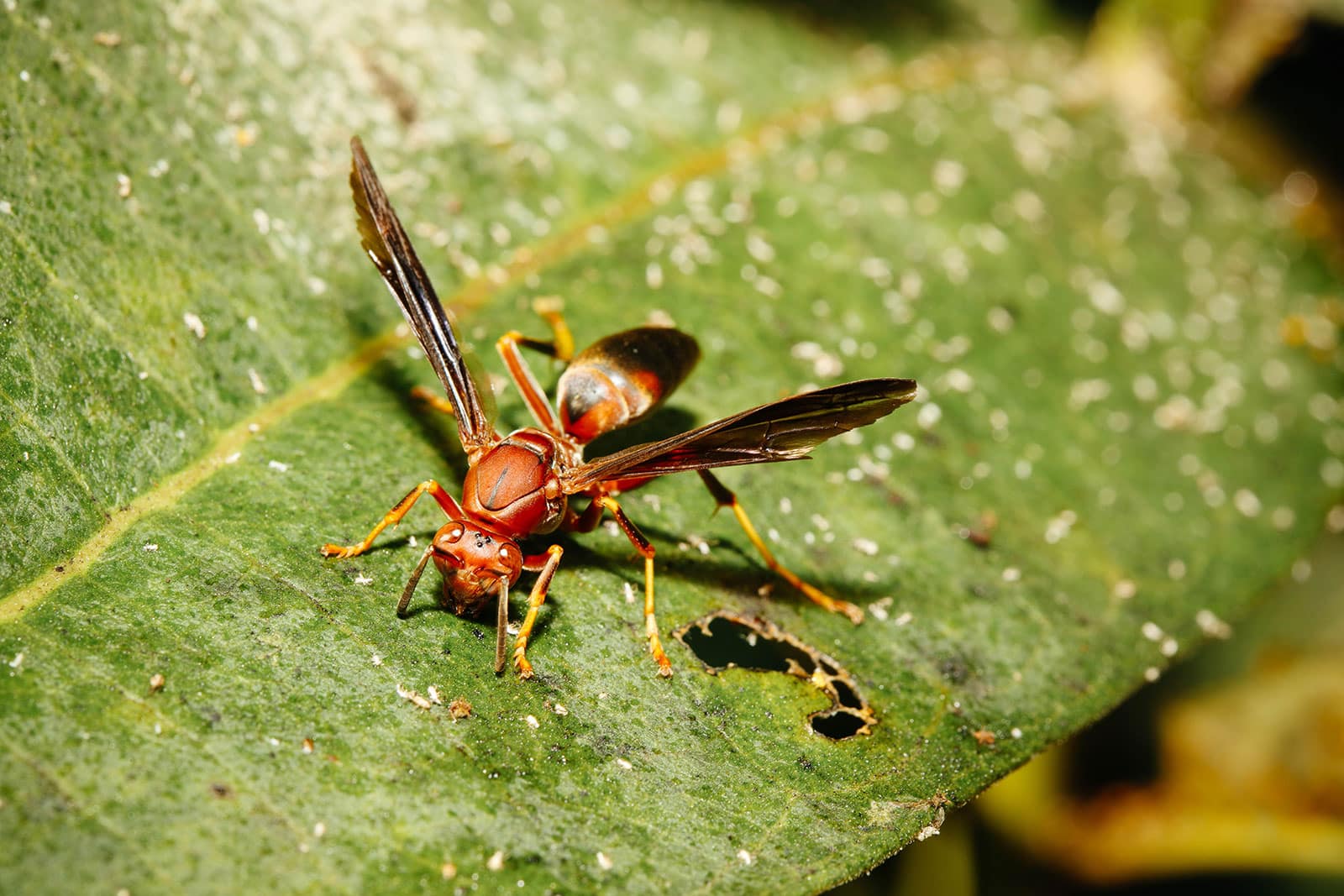
It’s not difficult to tell red paper wasps apart from their other cousins in the genus Polistes. As their name suggests, they’re a brownish red in color, with little or no yellow. They sport black wings.
Most common in the East and Midwest, with Polistes canadensis limited to a small part of Arizona, red paper wasps can build large nests and have the potential to become nuisances. They appear to be a bit more aggressive than the yellow-and-black paper wasps, and their stings can be painful.
Still, you don’t have to worry if the nest is not in your garden; lone workers shouldn’t bother you unless threatened.
Bald-faced hornet (Dolichovespula maculata)
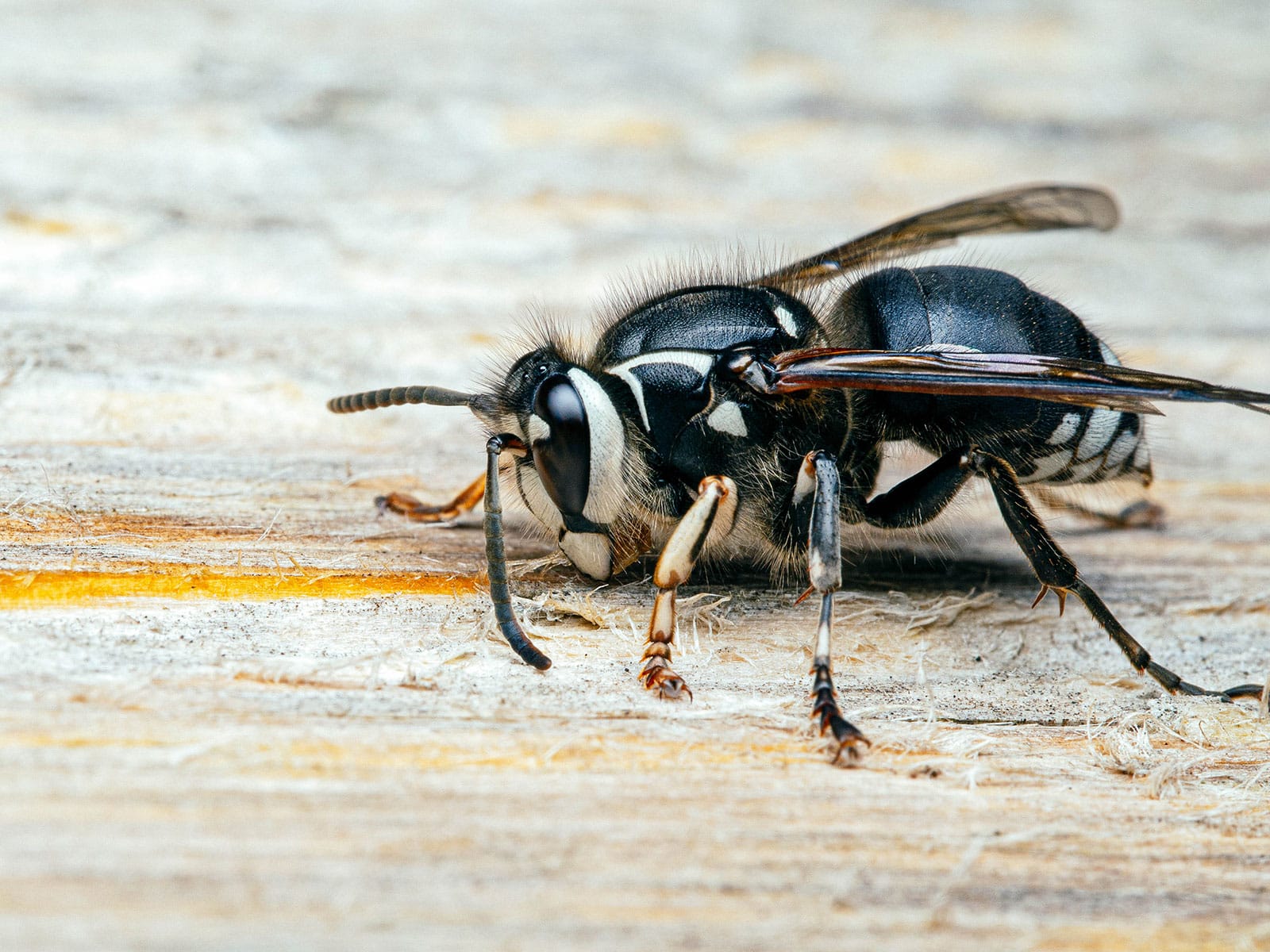
Although it’s commonly referred to as a hornet, its scientific name reveals what this wasp really is: a yellowjacket. True hornets are in the genus Vespa, after all.
Although it has swapped the yellow markings for white with plenty of black, the yellowjacket temperament is absolutely still there with bald-faced hornets.
In fact, this is one of the more problematic yellowjackets out there, and it even has the capacity to spray venom. It has a wide spread within the US, although it’s most common in the Southeast. Individual workers won’t cause problems, but you should avoid their papery nests!
Mud dauber (families Sphecidae and Crabronidae)

The common name of mud dauber applies to a number of wasp species that make nests out of mud. There are quite a few different types of mud daubers present in the US, but luckily, none of them tend to cause much trouble.
They’re solitary and will defend their nests, but stings aren’t that common. Some species hunt spiders.
It’s not difficult to recognize a mud dauber. Depending on the species, its nest may look like neat pipes or tunnels, or more like a simple pile of dirt.
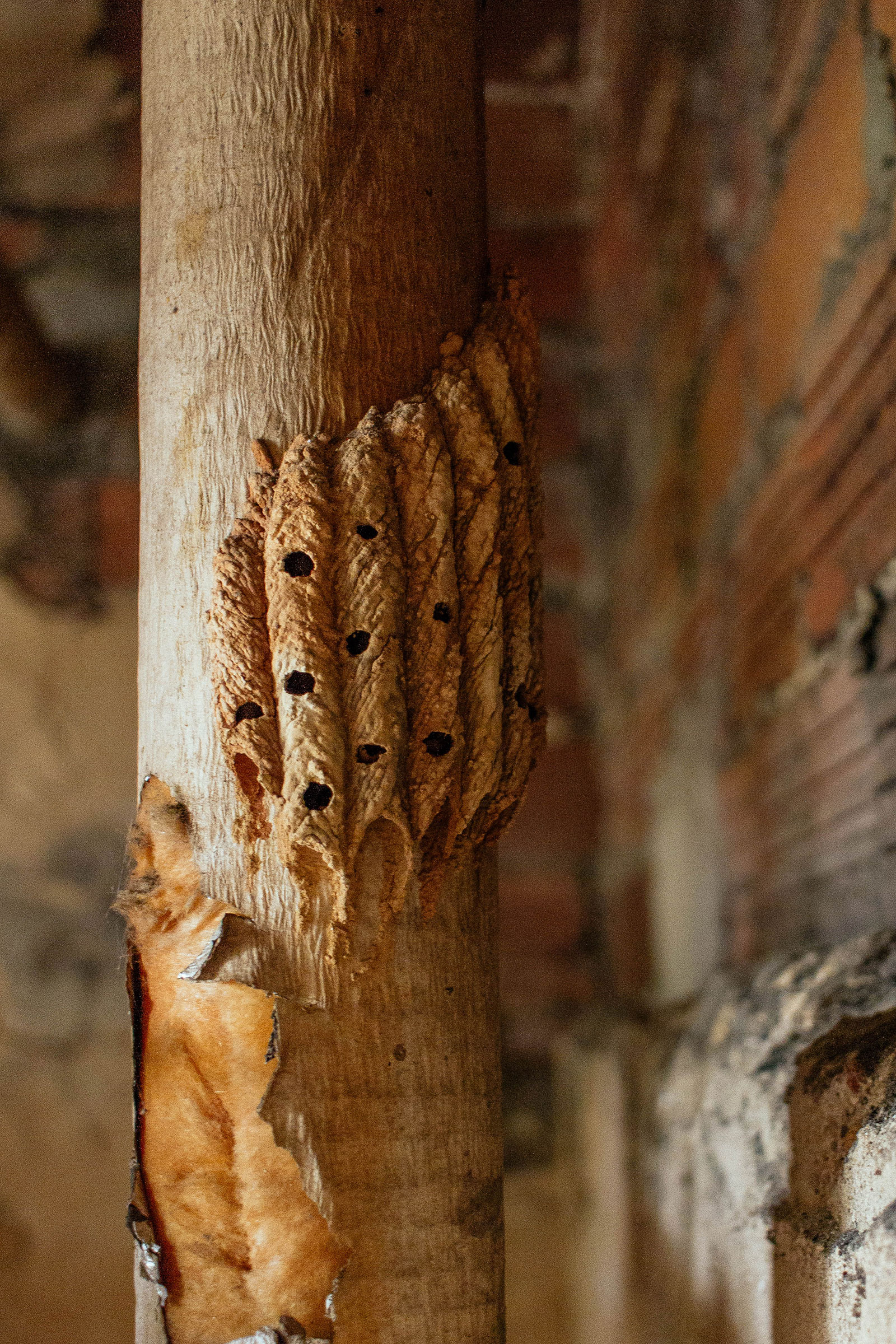

The wasp itself is characterized by its extremely thin “waist” and slender appearance. Color-wise, mud daubers range from yellow and black to an iridescent blackish blue.
Velvet ant (family Mutillidae)
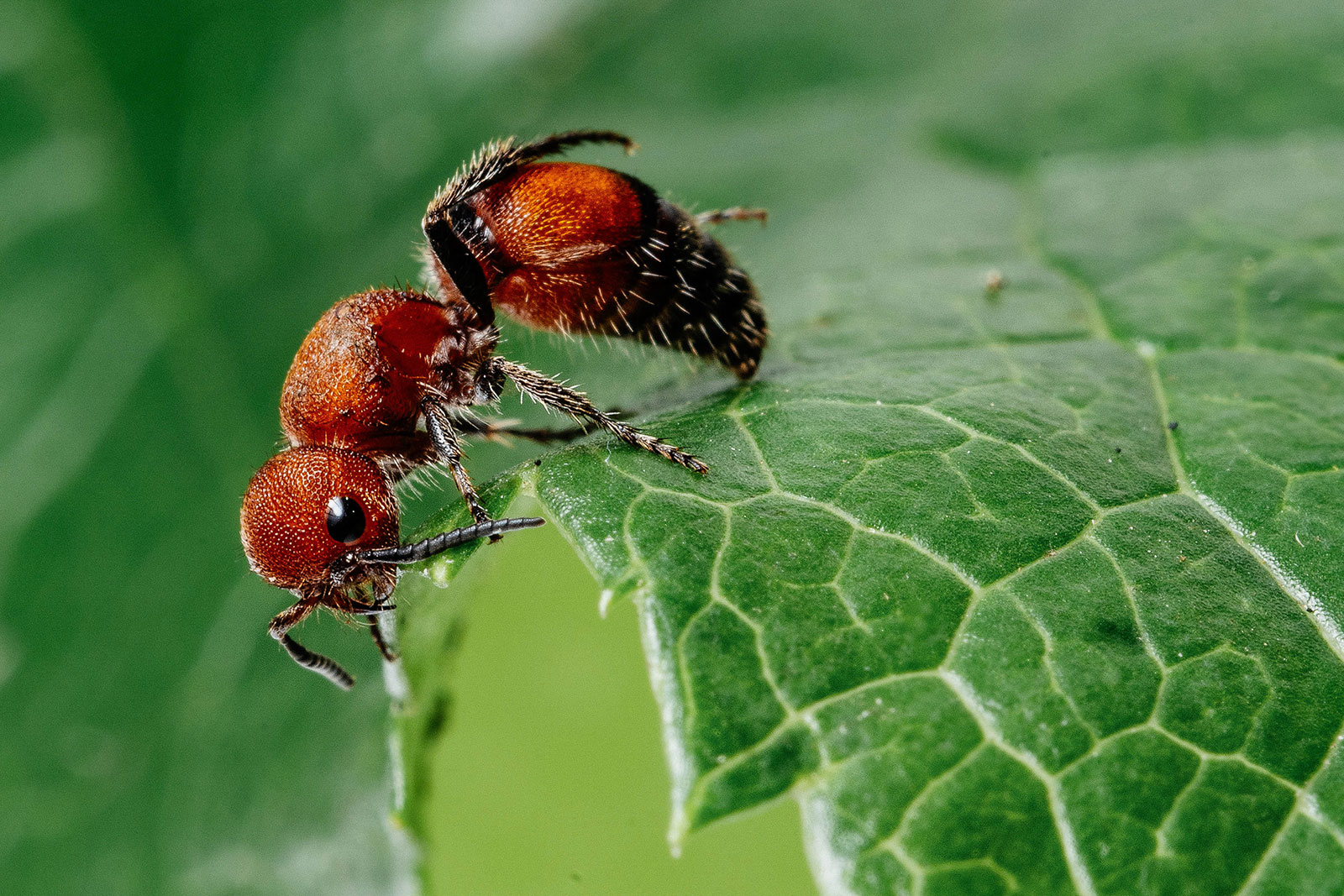
If you spot a velvet ant, you may not even realize it’s actually a wasp: These hairy insects look more like a cross between a bumblebee and an unusually large ant. The females don’t even have wings!
Velvet ants are parasitoid, laying eggs in other wasp nests so their young can consume the existing larva and take over.
The most well-known velvet ant is Dasymutilla occidentalis, which can be found in the Eastern US. This species is known as the cow killer due to its extremely painful sting.
Luckily, it’s not common for a human to get stung, and although the sensation is apparently pretty excruciating, these wasps aren’t particularly venomous.
Sand wasp (genus Bembix)
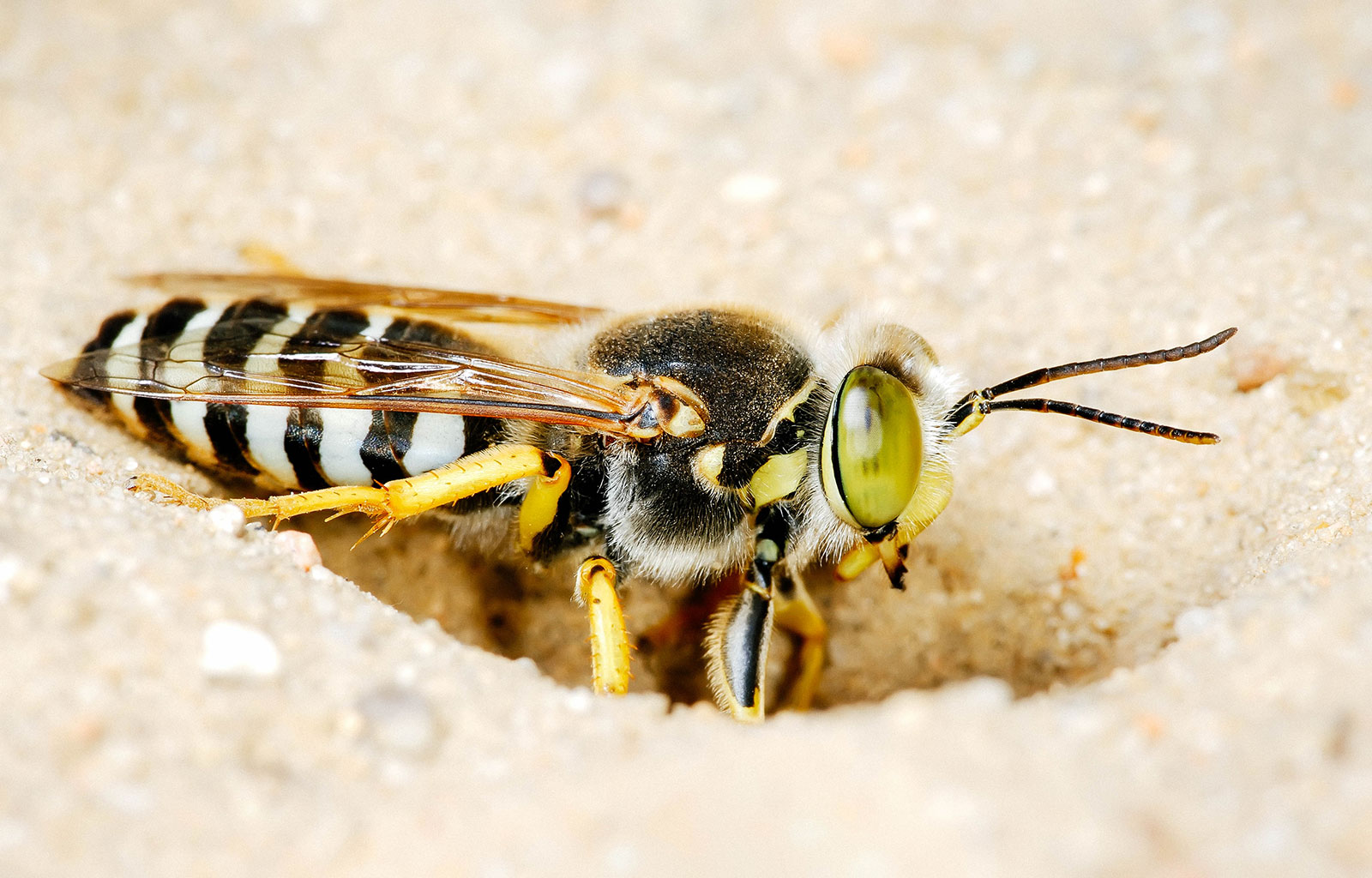
There are over 1,000 species of sand wasps present in the United States, but chances are you’ve never even heard of these insects. That’s because they mostly keep to themselves: These guys are solitary and nest in sandy holes.
Many sand wasps have a whitish-yellow and black striped pattern typical for wasps, but their eyes are much bigger than most other species. This makes them easy to confuse with bees or hover flies.
If you find one in your garden, just leave it be. It generally won’t stick around for long and only stings if you accidentally squash or threaten it.
Cuckoo wasp (family Chrysididae)
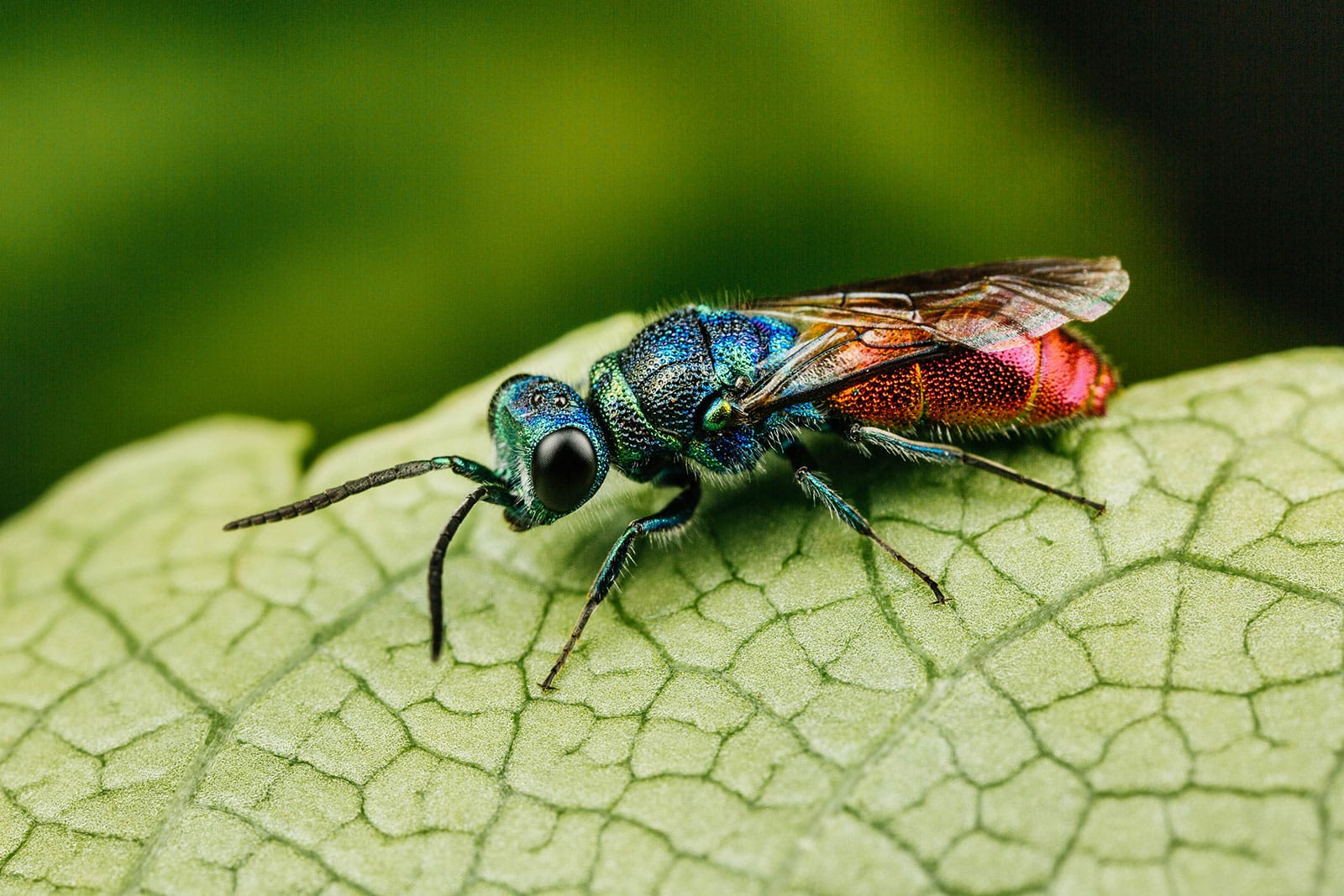
If there was a beauty prize for wasps, it’d probably go to this family of jewel-toned iridescent insects.
The cuckoo wasps are a fascinating family, deriving their name from the fact that, like some of their other wasp cousins, they are parasitoid. They’re most common in California and other arid regions.
Unlike true parasites, they don’t live inside their host, but they still kill it. Just like cuckoo birds, female cuckoo wasps lay their eggs in the nests of close relatives (mainly other solitary wasps and bees). Once the baby wasp hatches, it eats the already present larva as well as any other food present.
You can leave cuckoo wasps to do their thing in your garden. They’re mostly unable to sting, and their parasitoid nature means they actually help with population control of wasp species that do.
Potter wasp (genus Eumenes)

If you’ve seen a potter wasp’s nest before, you’ll know exactly where these guys get their name from. Made of mud, their nests really do look like a piece of pottery, specifically a jug with a thin neck and bulbous base.
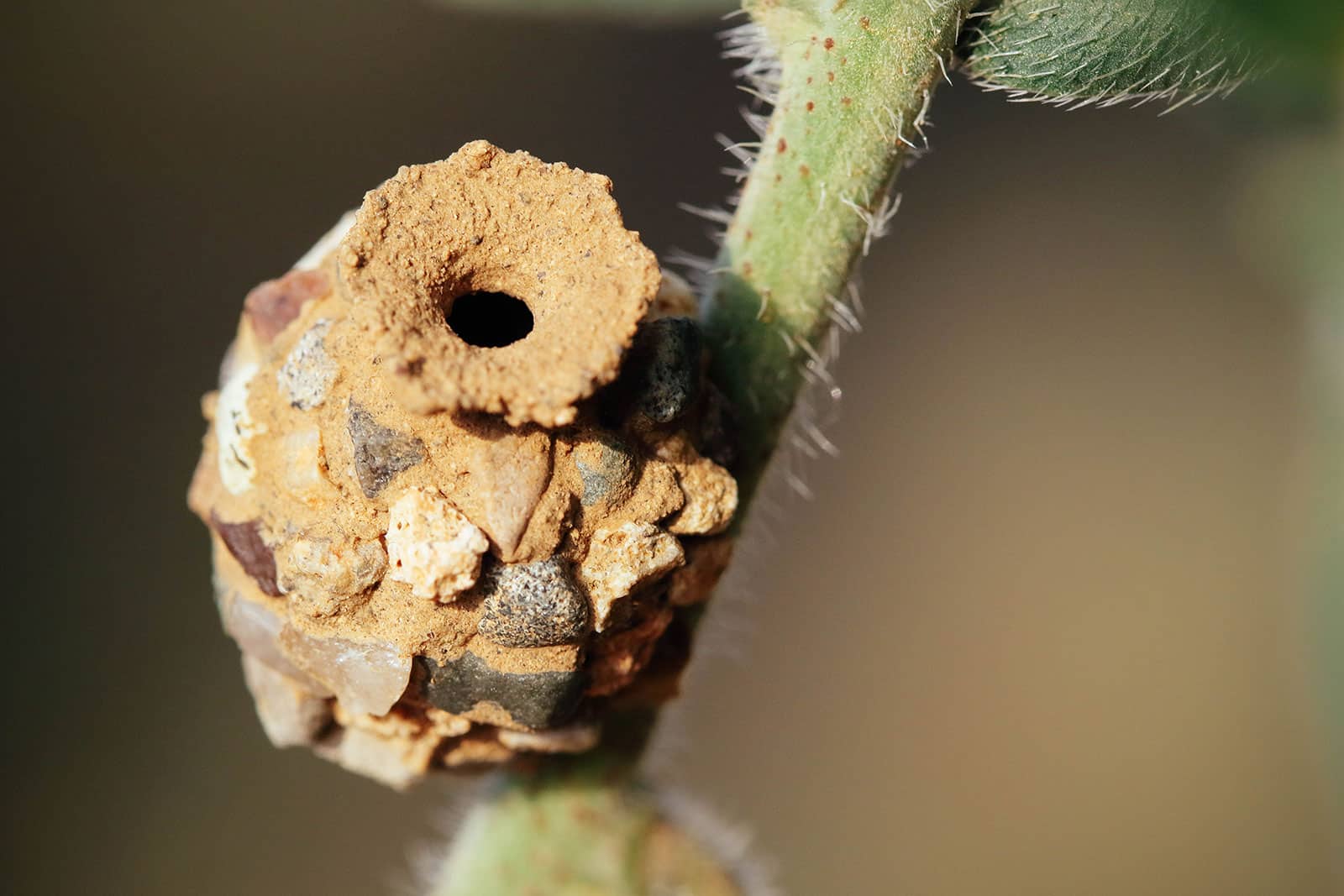
Potter wasps themselves can look intimidating, with typical wasp colors, thin waists, and pointy abdomens. However, they’re not very large (under an inch), and will rarely sting.
Just leave them alone to catch the caterpillars that they use to feed their young! That way, there are less caterpillars to eat your backyard plants.
Mason wasp (genus Monobia)

Another genus of proficient makers of mud nests, the mason wasps (Monobia) are considered to be in the same scientific subfamily as the potter wasps: Eumeninae.
The most well-known North American variety is the four-toothed mason wasp, Monobia cuadridens. This black-and-white species looks a lot like the previously mentioned bald-faced hornet and is mostly found in the Eastern states.
Like many asocial wasps, the mason wasp can sting, but it’s not really an insect to worry about.
Digger wasp (genus Sphex)

As its name suggests, the digger wasp is a solitary species that makes its nest in an underground burrow.
There are several species of digger wasps you may find in your backyard in the US, with the most common one probably being the great black wasp (Sphex pensylvanicus).
Another species is the narrow-waisted, black-and-orange great golden digger wasp (Sphex ichneumoneus).
The great black wasp can be quite a sight to see, since they’re jet black and quite large (over an inch). Their stings are painful but not common at all, and they’re useful bug catchers.
Gall wasp (family Cynipidae)
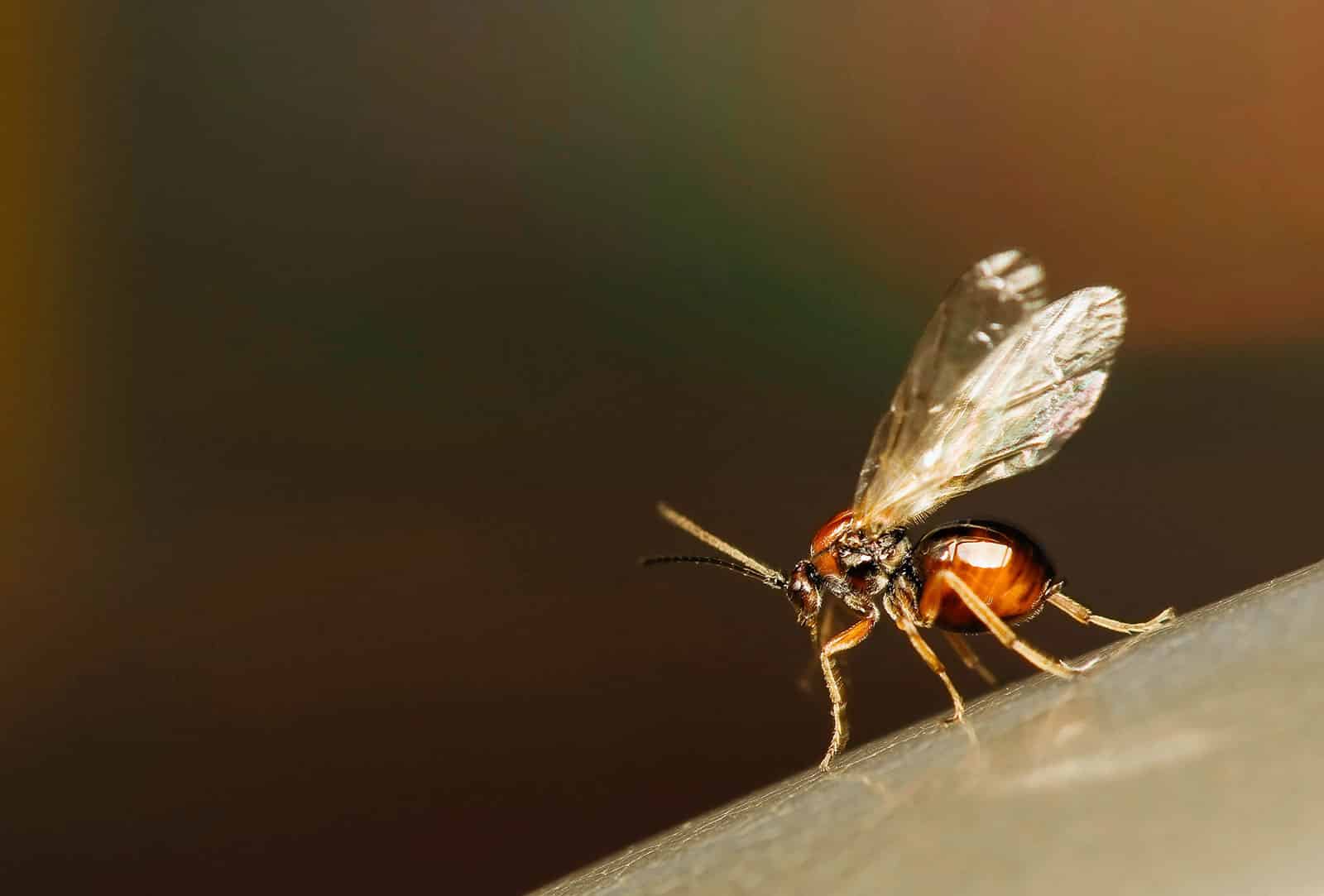
There are apparently a whopping 800 species of gall wasps in North America, but you’re unlikely to come across live ones much.
It’s not that they’re not there, they’re just really tiny! (Growing to a maximum of 0.3 inch.)
What you’re more likely to see are the galls they produce on the plants that they inhabit. Basically, the gall wasp lays eggs on a plant, causing it to develop a sort of wart for reasons still not entirely clear. This gall envelops the larva and provides it with food.
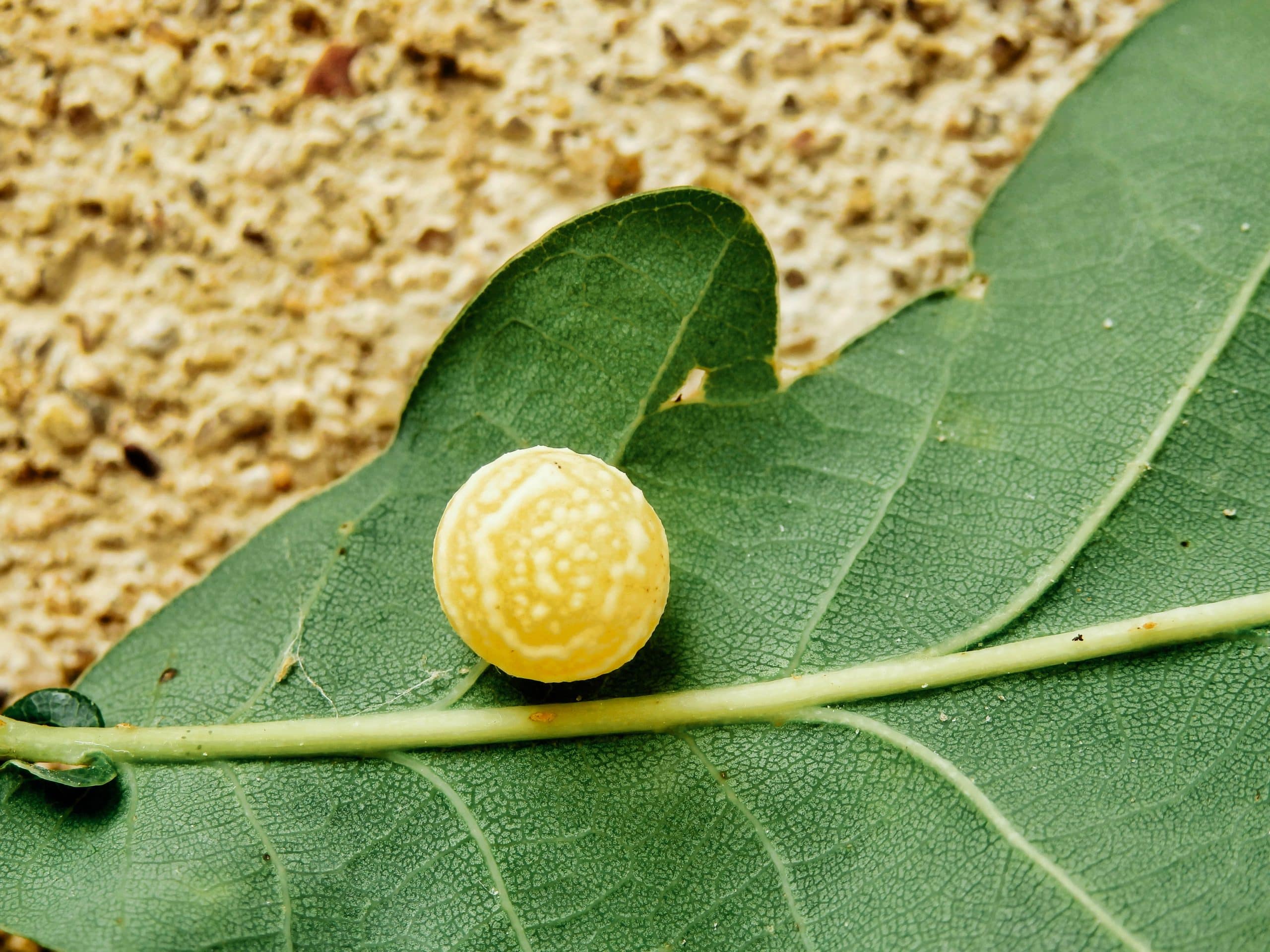
If you see galls on your trees, there’s usually no need to worry. Unless it’s been thoroughly infested, a few gall wasps won’t do much damage.
Spider wasp (subfamily Pompilidae)
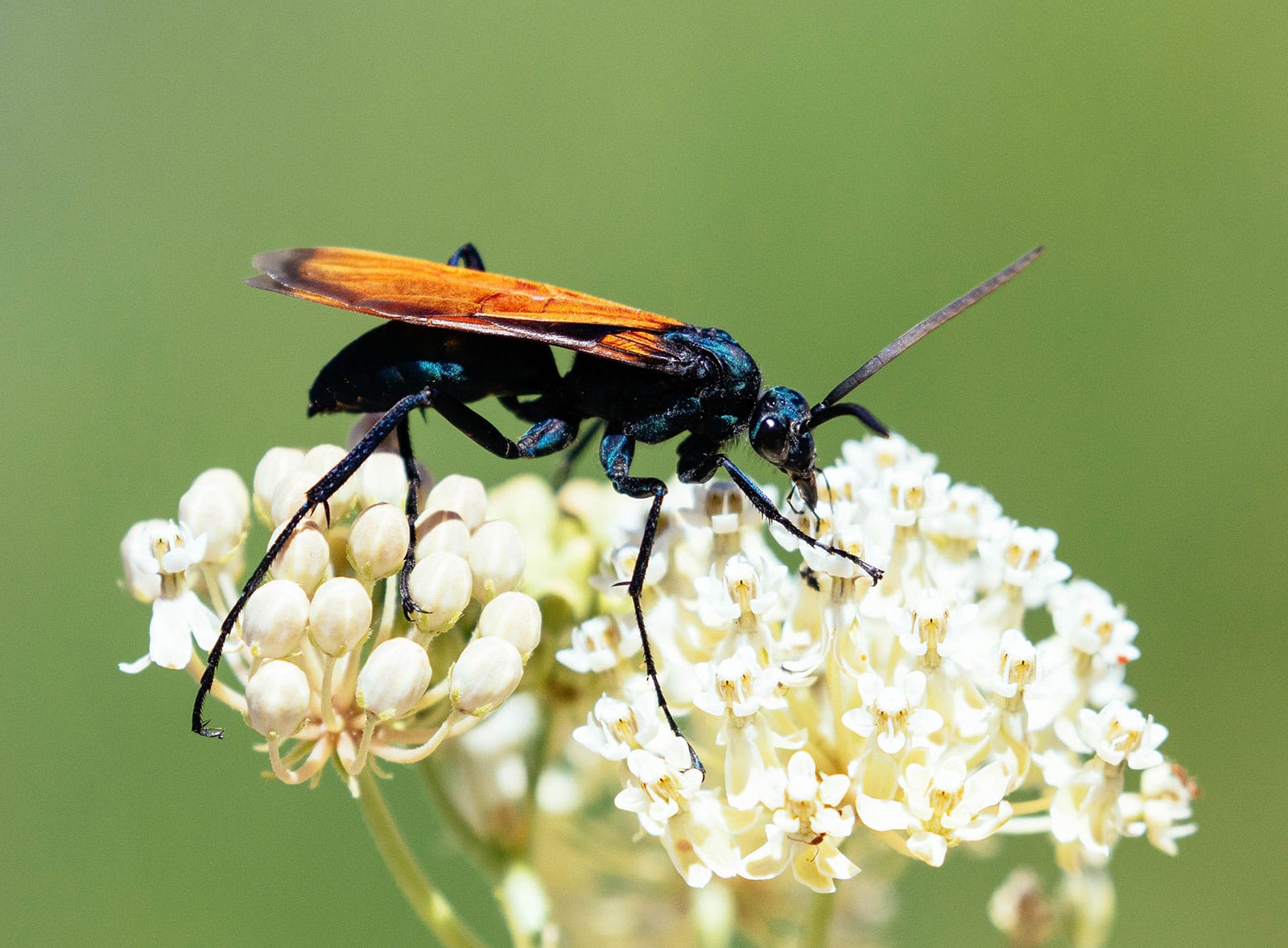
If you don’t like spiders, you’ll be happy to learn that there’s a genus of wasps that feeds exclusively on these eight-legged bugs (although if you don’t like wasps either, this fact may leave you feeling conflicted).
The spiders don’t die quickly either: They are paralyzed, dragged to the wasp’s nest, covered with an egg and then left for the larva to feed on once it hatches. Ah, nature! The circle of life is so wacky sometimes.
The most well-known spider wasp is the tarantula hawk (genus Pepsis), which does in fact feed on tarantulas. It also happens to pack one of the most debilitating insect stings in the world!
Luckily, the furthest north this orange-winged menace occurs is Utah, so most parts of the country are unlikely to come across tarantula hawks.
If you do live in Utah or other areas south, your chances are 50/50, since it’s the female tarantula hawks that are out hunting tarantulas. About the only thing that male tarantula hawks attack are flowers; they spend their days feeding on nectar and waiting to mate.
Other spider wasps aren’t quite so scary or big. You’ll recognize them from their dark colors and their nervous wing flickering.
Ichneumon wasp (family Ichneumonidae)
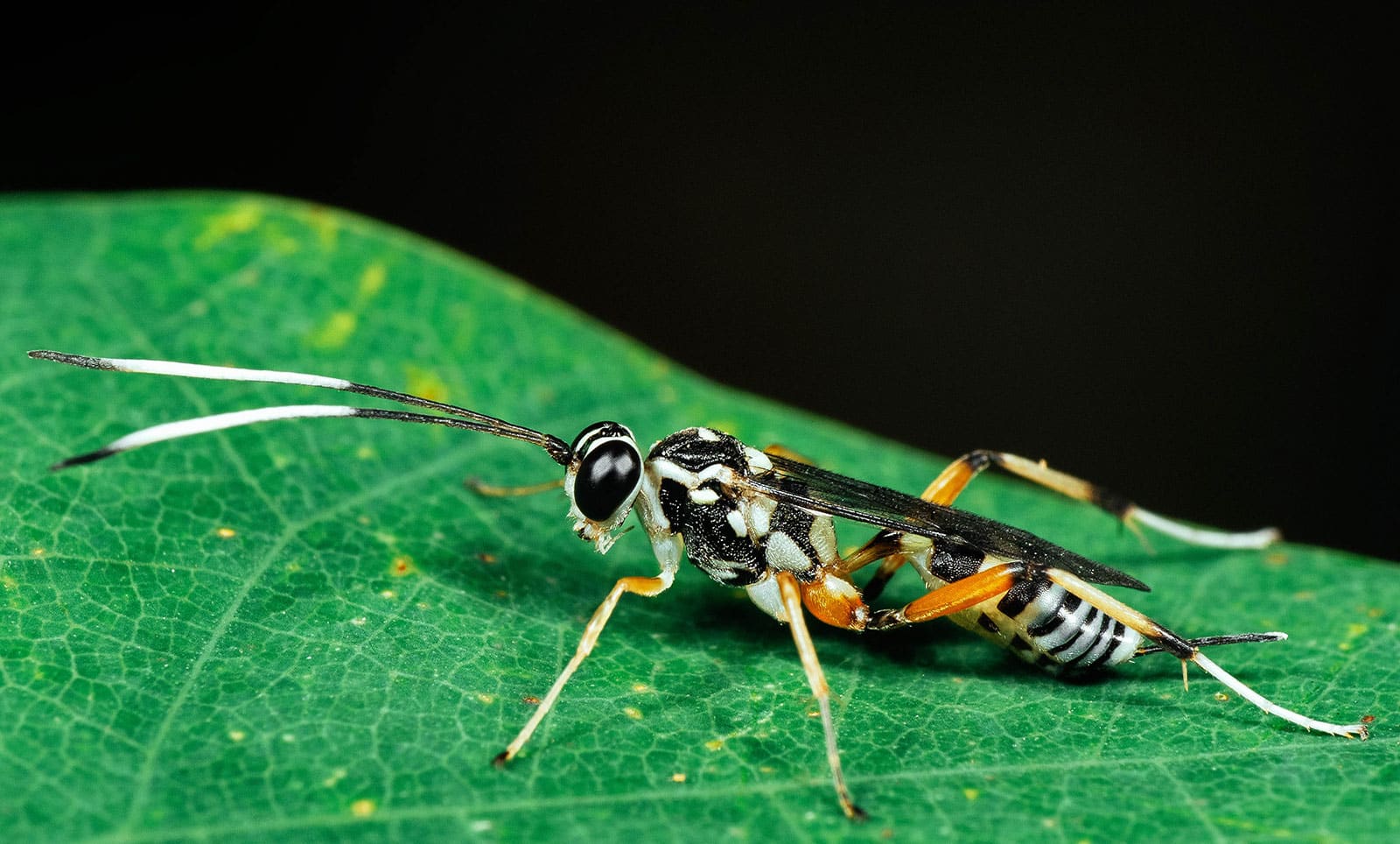
Similar to spider wasps, Ichneumon wasp species (also sometimes referred to as Darwin wasps) are parasitoid.
They just have a different specialization: Ichneumons feature an extra-long ovipositor, which they use to penetrate tree bark and lay eggs in the larvae of moths or beetles. After the wasp larvae hatch, they eat their host. It sounds gross, but it’s helpful in keeping insect populations under control!
Although they look like they have an impressive stinger, most of these wasps have actually lost the ability to sting. The few that haven’t are really not much for you to worry about.
Scoliid wasp (family Scoliidae)

We’ve discussed quite a few parasitoid wasp species so far, but Scoliid wasps may be among the most useful.
This family of usually blackish wasps, which have patterns of red and yellow, employs a similar tactic to spider wasps: dragging paralyzed prey to their nest for their larvae to feed on.
The cool thing? Scoliid wasps do this with the larvae of some highly damaging invasive bug species, like the Japanese beetle! Since they don’t sting unless you bother them, I’d say this is one wasp to welcome in your yard.
Related reading: 6 Smart Tricks That Get Rid of Fig Beetles (Naturally!)
Tiphiid wasp (family Tiphiidae)
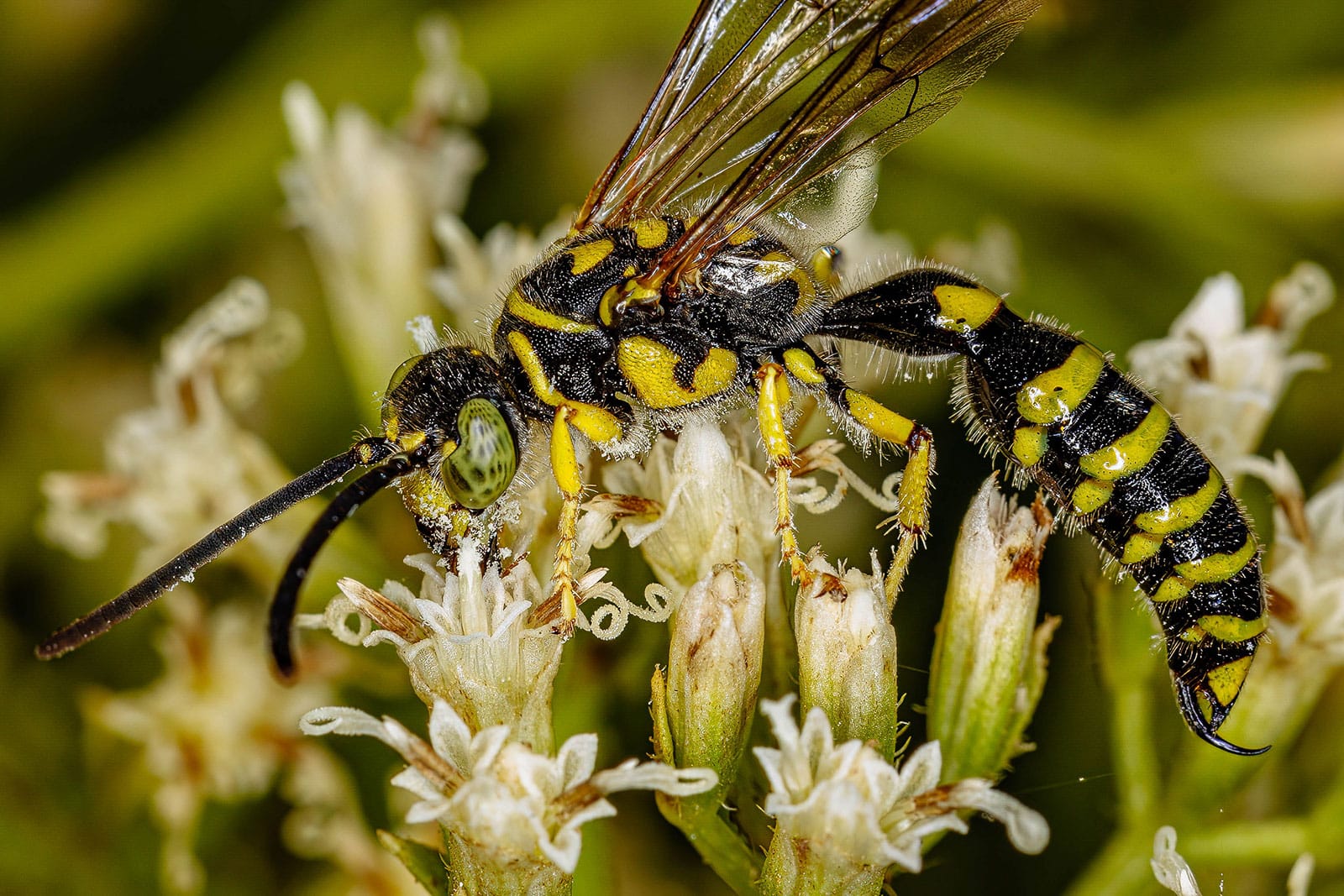
Also referred to as flower wasps, a nod to the adults’ diet, the Tiphiid wasps are similar to Scoliid wasps in their usefulness to combat pests. Not many species are native to the US, but a few have been introduced specifically to combat Japanese beetles.
Like yellowjackets and many other wasps, the Tiphiidae sport a yellow and black striped pattern.
This particularly applies to the five-banded Tiphiid wasp, Myzinum quinquecinctum, which is found in the Eastern US. The difference is in the shape of the abdomen, which is much more elongated than in other wasp species.
Cicada killer wasp (genus Sphecius)
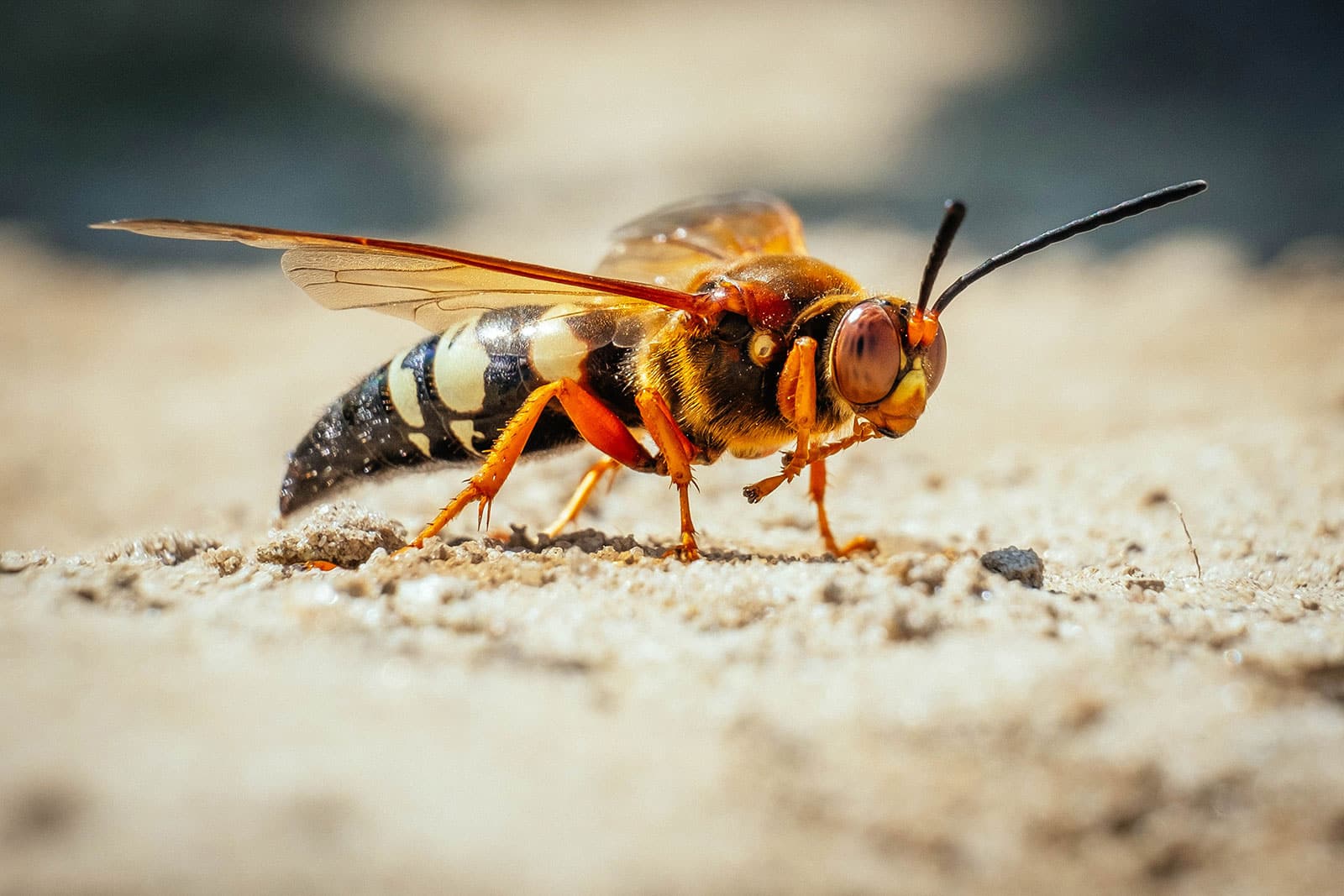
There are four species of cicada killer wasps present in the United States, mostly found in the East, West, and Midwest. Members of the digger wasps, these species can be alarming to find in the backyard, as they grow quite large.
However, despite their whopping size of up to 2 inches, their sting is meant exclusively to paralyze their prey (cicadas, as you’ve probably guessed). The sting is said to be not too painful to humans.
Although cicada killers are useful in that they will reduce the number of cicada screaming their heads off in your garden, they can cause issues if there are a lot of them. Their burrowing behavior can lead to dead patches in lawns!
Did you know?
You may have heard of the Asian giant hornet, better known colloquially as the “murder hornet.” There is a lot of nervousness about this Asian native invading the United States, as they are highly aggressive and have been responsible for human deaths. They’re also a big danger to honey bees.
Luckily, it appears that Asian giant hornets haven’t managed to gain a solid foothold for now. Various nests were spotted in Washington and across the Canadian border starting in 2019, but to entomologists’ relief, there wasn’t much buzz about these wasps in 2022. Many “murder hornet” sightings are actually cicada killer wasps.
Which wasps have the most painful sting?
For this, let’s refer to the Schmidt sting pain index, compiled by a guy (entomologist Justin O. Schmidt, known as the “King of Sting”) who has quite a flair for descriptive language and been (willingly!) stung by pretty much everything that stings—83 different insects, to be exact. (Yikes!)
Most wasp stings are painful, but not too problematic. Schmidt rates a yellowjacket sting at about 2 out of 4. Red paper wasps and velvet ants are a 3 out of 4.
The 4 out of 4 rating is reserved for:
- Pepsis grossa, a species of tarantula hawk (wasps that prey on spiders, including tarantulas). This one is found in the southern US and Central America. Schmidt describes its sting as “Blinding, fierce, shockingly electric. A running hair dryer has just been dropped into your bubble bath.”
- Synoeca septentrionalis, the warrior wasp. Luckily this one is tropical and doesn’t occur further north than Mexico, but Schmidt has this to say about its sting: “Torture. You are chained in the flow of an active volcano. Why did I start this list?”
By the way, American YouTube wildlife educator Coyote Peterson doesn’t agree. He rates the sting of the appropriately named executioner wasp (Polistes carnifex, which sometimes makes its way into Texas) as the absolute most painful.
What to know about wasps
How long do wasps live?
That completely depends on species and gender. Generally speaking, female worker wasps and male drones live for a few weeks to months. The queen, in species that have them, has a much longer lifespan. She can survive for up to a year.
Do wasps die after they sting you?
With a few uncommon exceptions, no. In fact, neither do many bees!
It’s mostly just honey bees that can’t pull out their stinger, causing them to die after stinging.
How to treat a wasp sting
If you get stung by a wasp, there isn’t much you can do besides washing the area with soap and water. An ice pack can reduce swelling and help numb the pain. In the vast majority of cases, you’ll feel fine again soon.
If you know you are allergic to wasp stings to the point of anaphylaxis, you should keep an Epi-Pen around.
If a person has been stung by a large amount of wasps, or exhibits symptoms of anaphylaxis, you should call 911. These symptoms include hives around the sting site, trouble breathing, and feeling faint.
What attracts wasps?
Nuisance wasps like yellowjackets are attracted by sweet foods, especially during the late summer months. This includes fruit trees. They likely also won’t say no to proteins like your tasty deli sandwich or hamburger.
To reduce wasp numbers, remove any fruit that is rotting or has fallen from your fruit trees. Keep garbage well-covered in closed bins. Cover picnic foods after serving, and don’t start flailing if you do get a flying visitor.
If a wasp is really ruining your BBQ, you could use an electric fly swatter to safely kill it. Make sure to get it on the first swoop. If that’s not your thing, you can also trap it under a glass and release it later.
When should you remove a wasp nest?
There is no easy answer, as it depends entirely on things like the type of wasp or the time of year.
For example, I’d feel comfortable removing a small paper wasp nest in the dead of winter when all the wasps are dormant or dead.
In some cases I wouldn’t even touch a wasp’s nest at all, like if the nest is far away for me to not disturb it and I can co-exist fine with the wasps. I regularly get European hornet nests and they’re actually quite cool to see when they fly past carrying prey. They’ve landed on me before and never displayed aggression.
If you’re dealing with something like a large, active yellowjacket nest, things change. If it’s in a dangerous spot, like close to where your children play, it’s probably best to call an exterminator.
Here’s a guide to help you get rid of wasps.


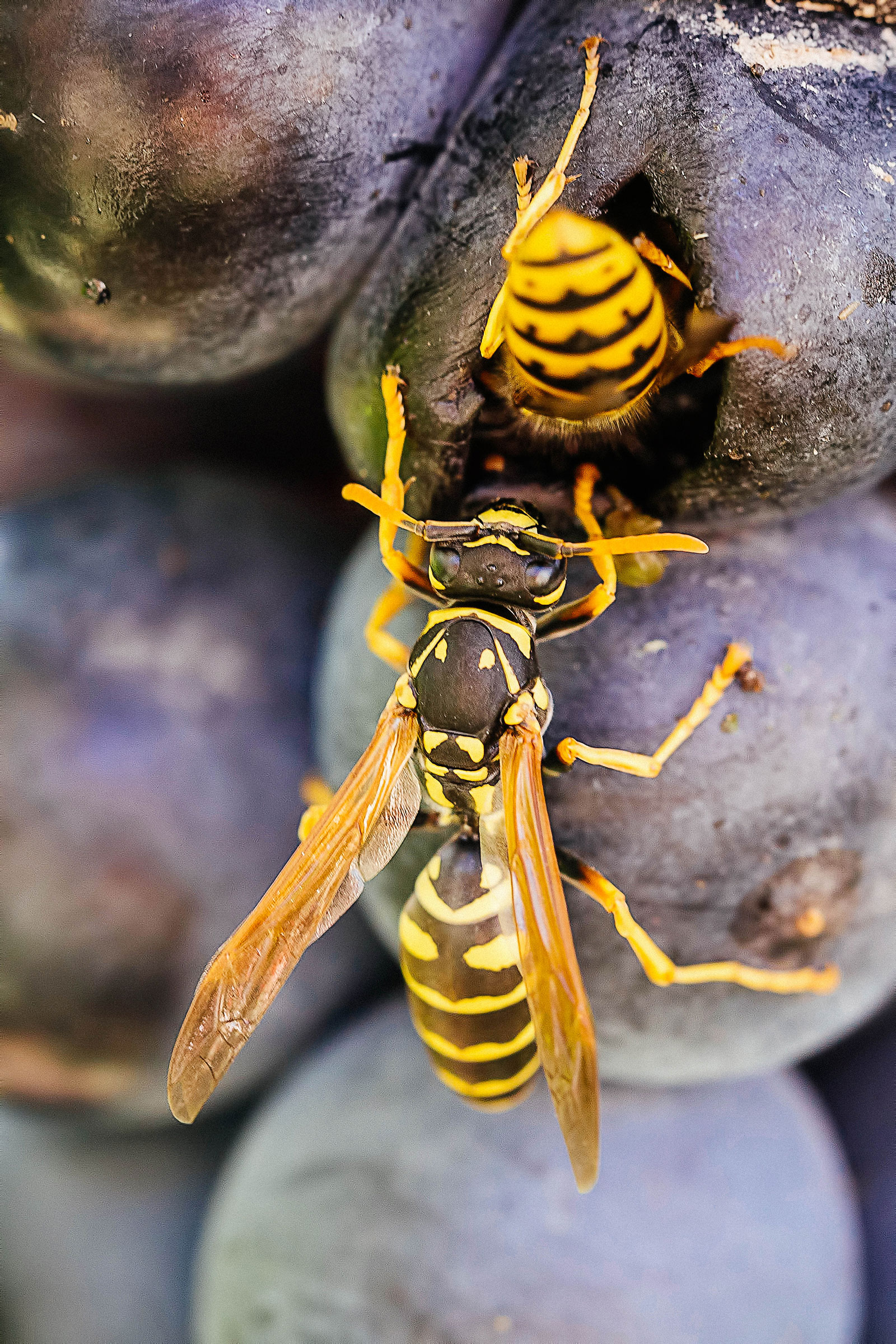

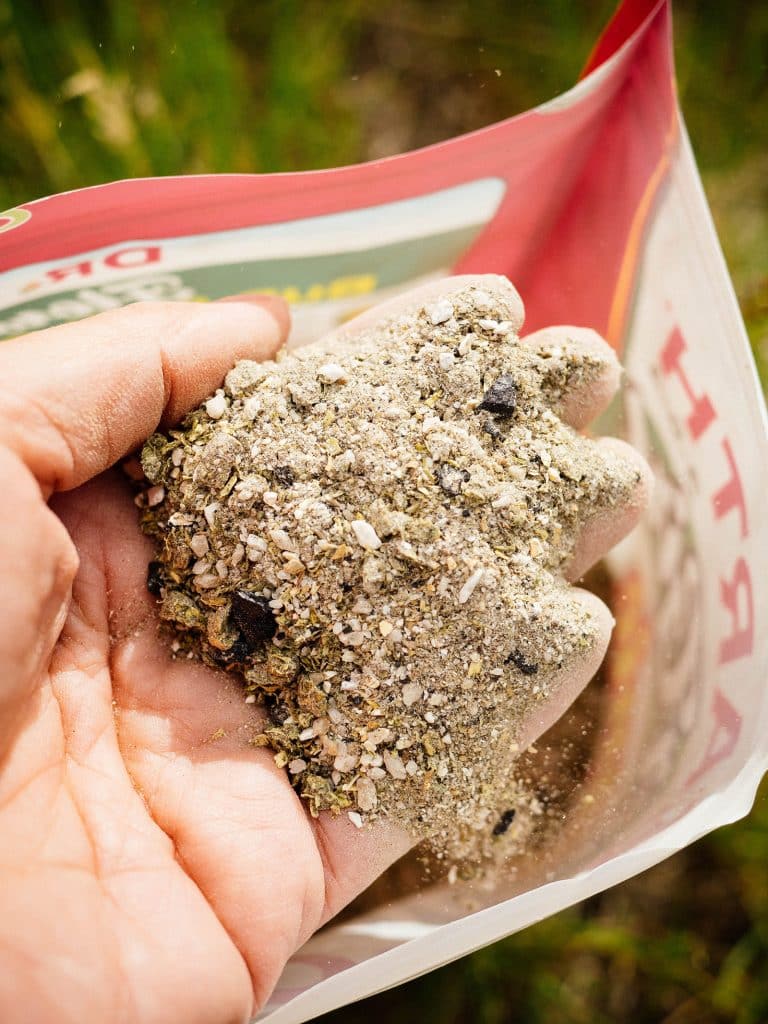
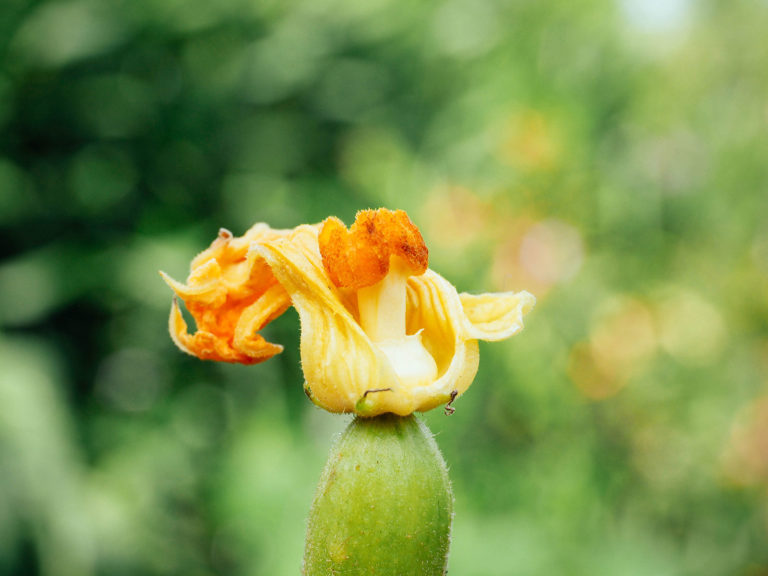
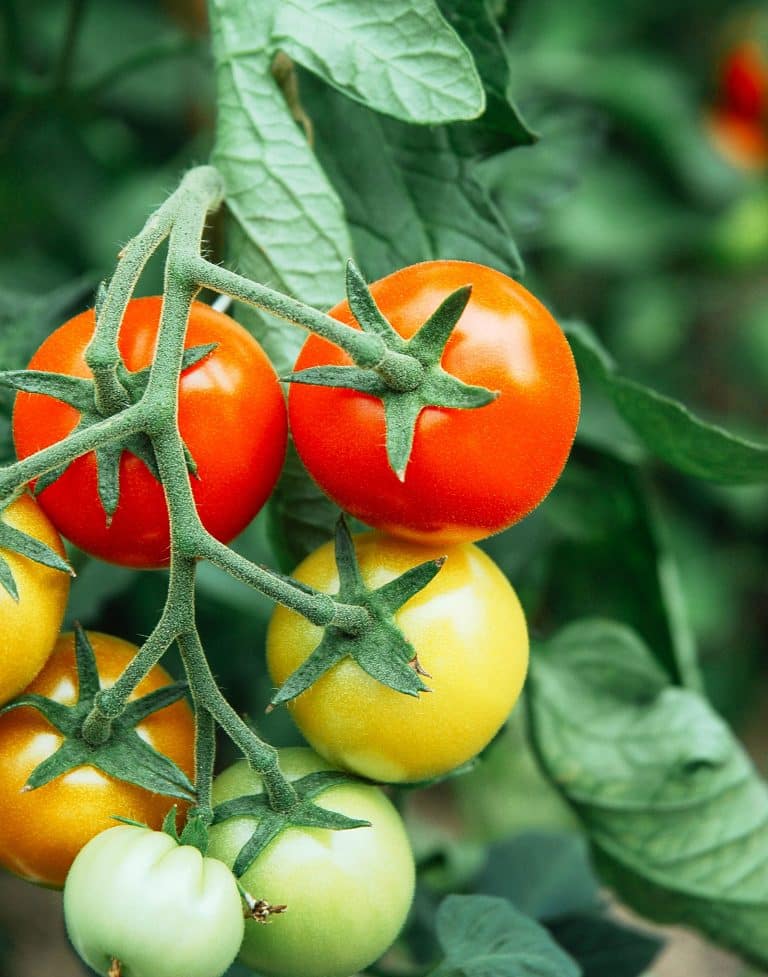





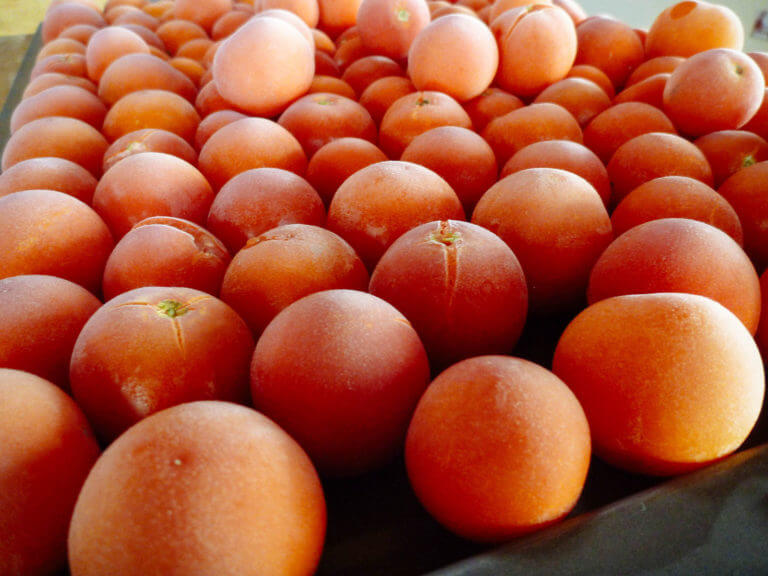

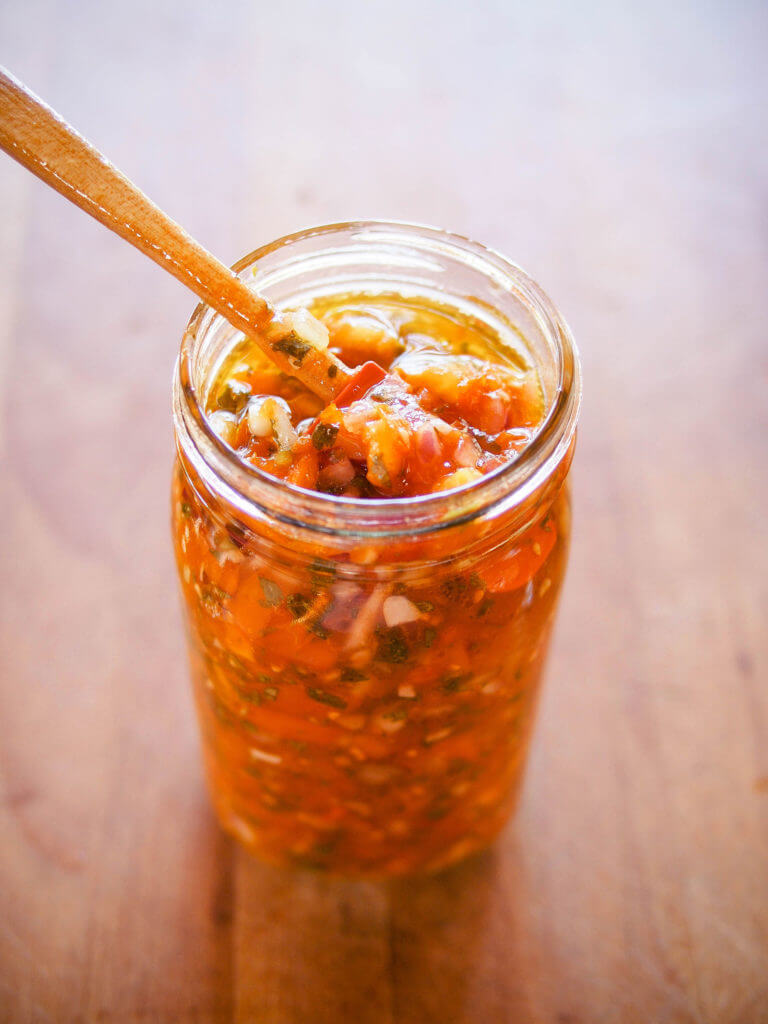

Great pictorial. I had flyswatters outside, can of wasp killer spray etc. always readily available. Then I got into organic gardening. The first tomato hornworm I saw zombified and parasitized with a mohawk of little cocoons on its back – and the fact that it was not eating my tomato – plant made me an immediate wasp fan.
My property is mostly old-growth hickory and oak but with a house and yard there’s always the verge and the human area. I have a plethora of habitats besides just the veggie garden. I have counted at least a 20 varieties, and have nests in several areas around the house with different paper wasp varieties in each spot.
What made me comment was the pollinator reference. All wasps pollinate – hairy or not. The bees only get the glory because humans make $$$ off honey. I have very few honey bees in the garden. My tomatoes are pollinated mostly by wasps, and my pappers are favored by the the big and little fuzzy-bumbles.
Moistened chewing tobacco will take the pain away immediately
What wasp has a black tail, red body with orange on the legs and antennae.?
I live in the (San Francisco) Bay Area, on the Peninsula, between SF and Palo Alto. I’ve had “Tarantula Hawk” wasp encounters twice now — one that I saw emerging from a hole in our yard, and more frighteningly, one that flew into a big Ziploc baggie of plant plugs in my garage right next to me. (Believe me, I got that baggie zipped fast and kept it that way for a few days.) Those things scare the heck out of me, after seeing videos of those nuts who let themselves get stung. Just thought I’d let people know: they ARE found in the greater SF Bay Area, and if you see one, find another place to be.
I have wasp that is about 10 centimeters long. It is black with no yellow markings. The translucent wings each have a large gray spot near the end. The antennae curl back significantly to the outside. I cannot id it. Can you?
10 centimeters? That’s nearly four inches. That’s some wasp!
Well wrote and informative article. Thanks
Hi! I’m trying to identify my inadvertent houseguest who arrived yesterday. It’s large with a yellow petiole (waist) and a black abdomen with no visible stinger (whew!). Its buzz is quiet. It seems to be attracted to the liqueur bottles on the bar and keeps trying to fly out the adjacent (closed) window. It also landed on the onions on the kitchen counter. I assuaged my poor husband’s terror by telling him it was just a robber fly, but we do have wasps making nests (paper or clay? I’m not sure) in the corners of the outside walls. Can you help me figure it out?
I can’t tell which wasp it is that’s preventing me from doing my gardening work.. but they keep flying around me wherever I go (almost like they’re stalking me)! Looks mostly like the yellow jacket or the European paper wasp.. they haven’t attacked me yet, and I don’t see any nests, but I feel like they’re warning me or something. Ugh hate them so much!!
We have had a lot of yellow jackets and bald faced hornets this summer. As one who has suffered anaphylaxis before from yellow Jacket stings, it was concerning. We took down most of the nests (2 underground, and 4 around the eves of the house) Now we have a different type of wasp hatching from the walls of the house? I can’t identify them. Black and white with brown patches. I was hoping to find out what sort of wasp it is. I first hoped it was some sort of saw fly, so I wouldn’t have to worry about stings. I have video and photos.
Thank you , I have been trying to id the wasp found in my g’house, A cicada killer wasp , in Shropshire UK. today, 27/07/2023
Excellent post, thank you. Cheers Diane
Hi! I’m staying on a very old homestead this summer,… the nest is underground,… the wasps are black with two bands on them thick and bright reddish orange, one on the upper body and one on the lobe. Are they a wasp or a hornet?
hi Linda, Bear here…
as a fan of wasps, I like the post. It’s good to show wasps aren’t as bad as people think.